 December 2023
December 2023Zofinger Luft (choice)
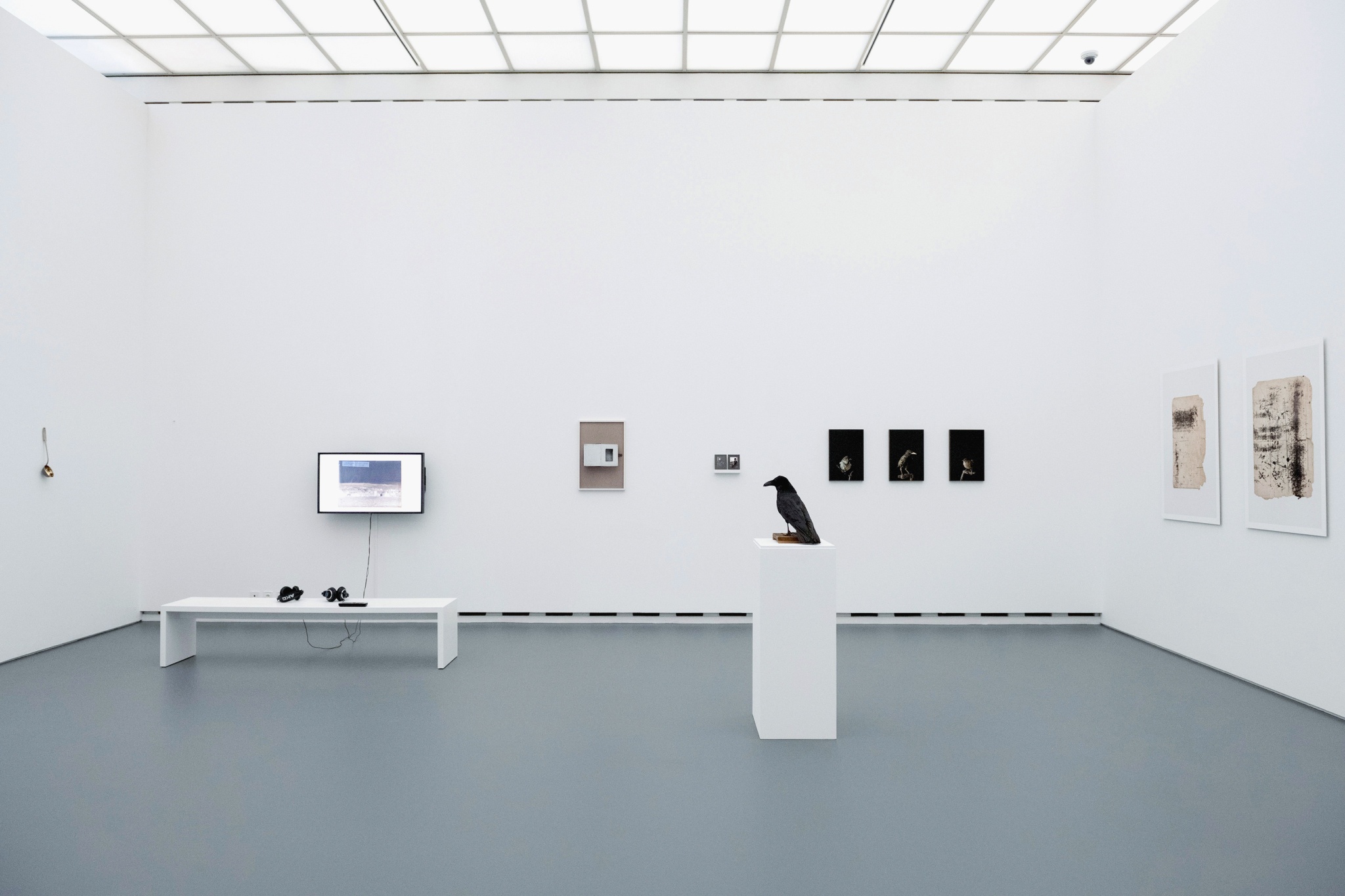
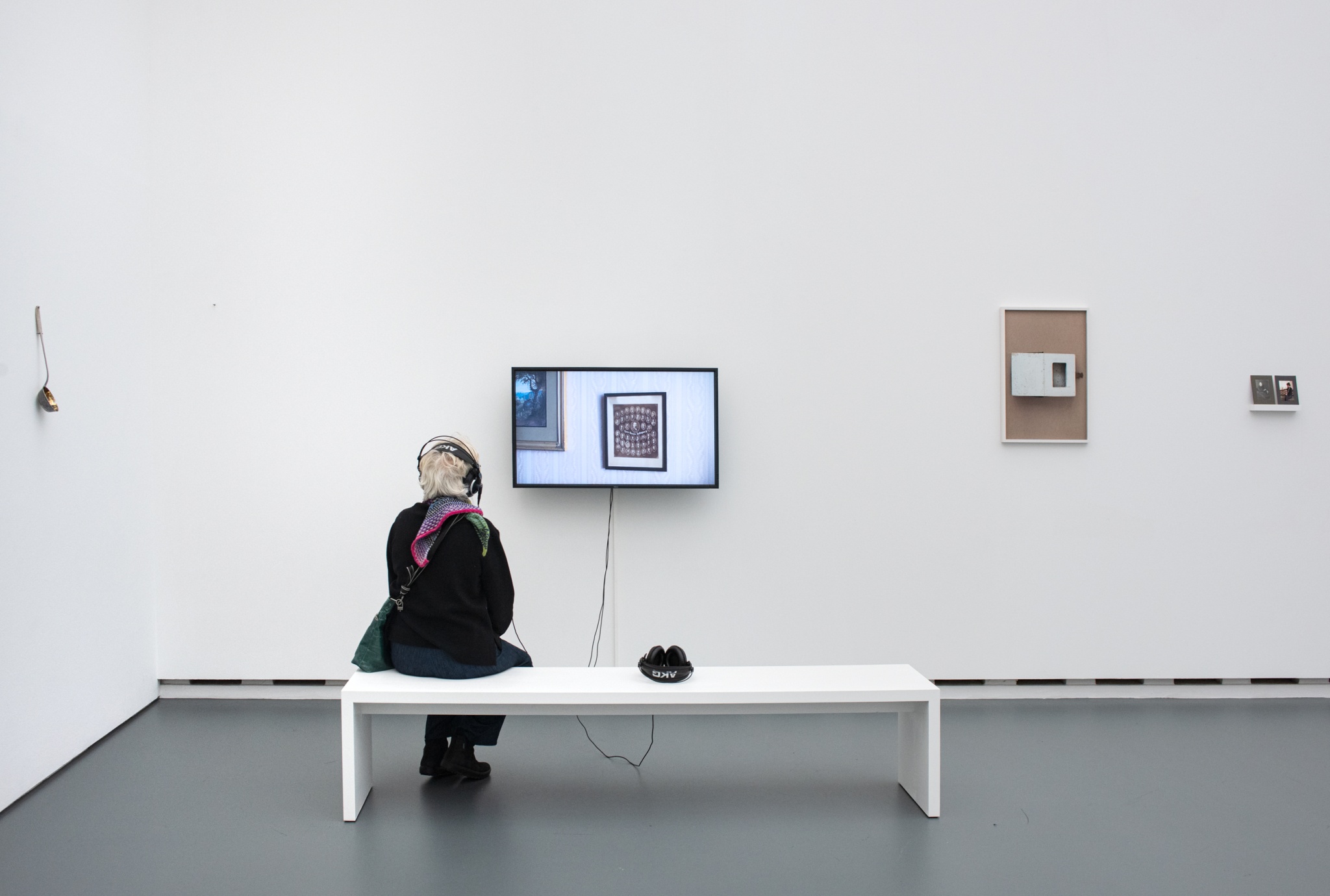






Exhibition view, Zofinger Luft, in the group exhibition, Mindmapping Art, Kunsthaus, Zofingen, 2023, Photo: Caroline Minjolles
Exhibition view, Zofinger Luft, in the group exhibition, Mindmapping Art, Kunsthaus, Zofingen, 2023
<p>Detail view, <em>Zofinger Luft</em>, in the group exhibition, Mindmapping Art, Kunsthaus, Zofingen, 2023</p>
Exhibition view, Zofinger Luft, in the group exhibition, Mindmapping Art, Kunsthaus, Zofingen, 2023
Detail view, Zofinger Luft, in the group exhibition, Mindmapping Art, Kunsthaus, Zofingen, 2023
Video still, Zofinger Luft 1878 - 1892, in the group exhibition, Mindmapping Art, Kunsthaus, Zofingen, 2023
Video still, Zofinger Luft 1878 - 1892, in the group exhibition, Mindmapping Art, Kunsthaus, Zofingen, 2023
Video still, Zofinger Luft 1878 - 1892, in the group exhibition, Mindmapping Art, Kunsthaus, Zofingen, 2023
8 x Fotografien: Inkjetdruck auf Innovapapier, 118 x 80 cm, 60 x 40 cm, 87 x 60 cm, 45 x 30 cm, 15 x 10.8 cm
1 x Video: HD 16:9, 1920 x 1080, Farbe, 9:52, Ton
1 x Silberner Suppenlöffel
1 x Ausgestopfter Rabe
Für die "Auswahl 23" im Aargauer Kunsthaus habe ich einen Teil meiner mehrteiligen Arbeit ZOFINGER LUFT ausgestellt, welche im Frühling 2023 in der Gruppenausstellung “Mindmapping Art” im Kunsthaus Zofingen gezeigt wurde.
In dieser Arbeit recherchiere ich zu meiner Urgrossmutter Clara Bollag und deren Familie, im Zusammenhang mit der Ortsgeschichte Zofingens. Clara Bollag hatte seit ihrer Geburt 1884 in Zofingen gelebt, bevor sie 1904 zum Ursprungsort ihrer Familie, nach Endingen zog. Auf den Spuren meiner Urgrossmutter besuchte ich das Museum Zofingen, die Bibliothek und das Stadtarchiv Zofingens, recherchierte im Archiv des Turnvereins Zofingens, führte Gespräche mit Bewohner*innen und suchte nach Spuren meiner jüdischen Vorfahren.
Das Resultat dieser Recherche ist eine mehrteilige Installation, welche sich aus Fotografien, einem Video, persönlichen Objekten aus dem Nachlass meiner Familie, sowie Fundstücke aus dem Musuem Zofingens zusammensetzt.
 August 2023
August 2023Durchfluten
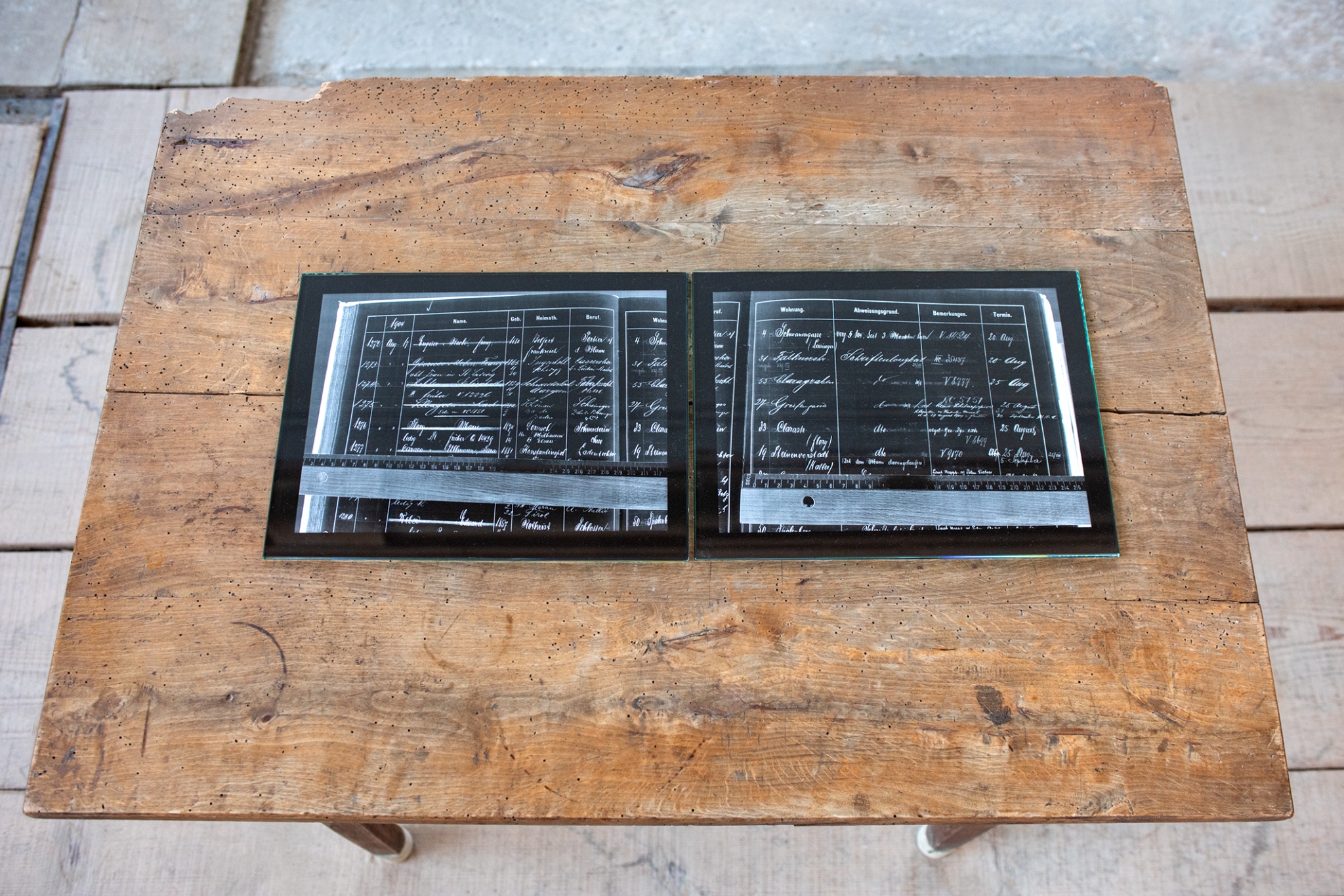
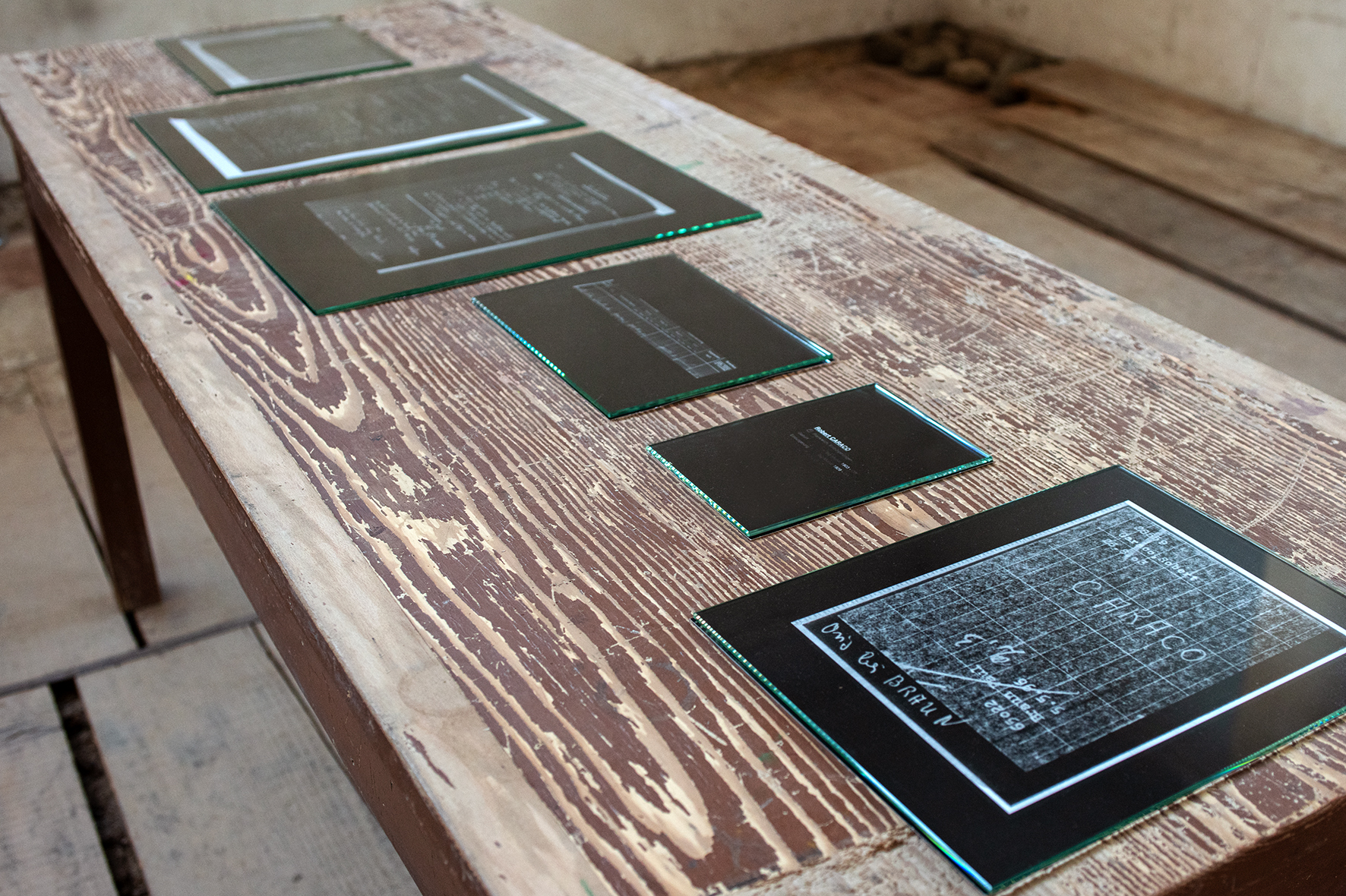




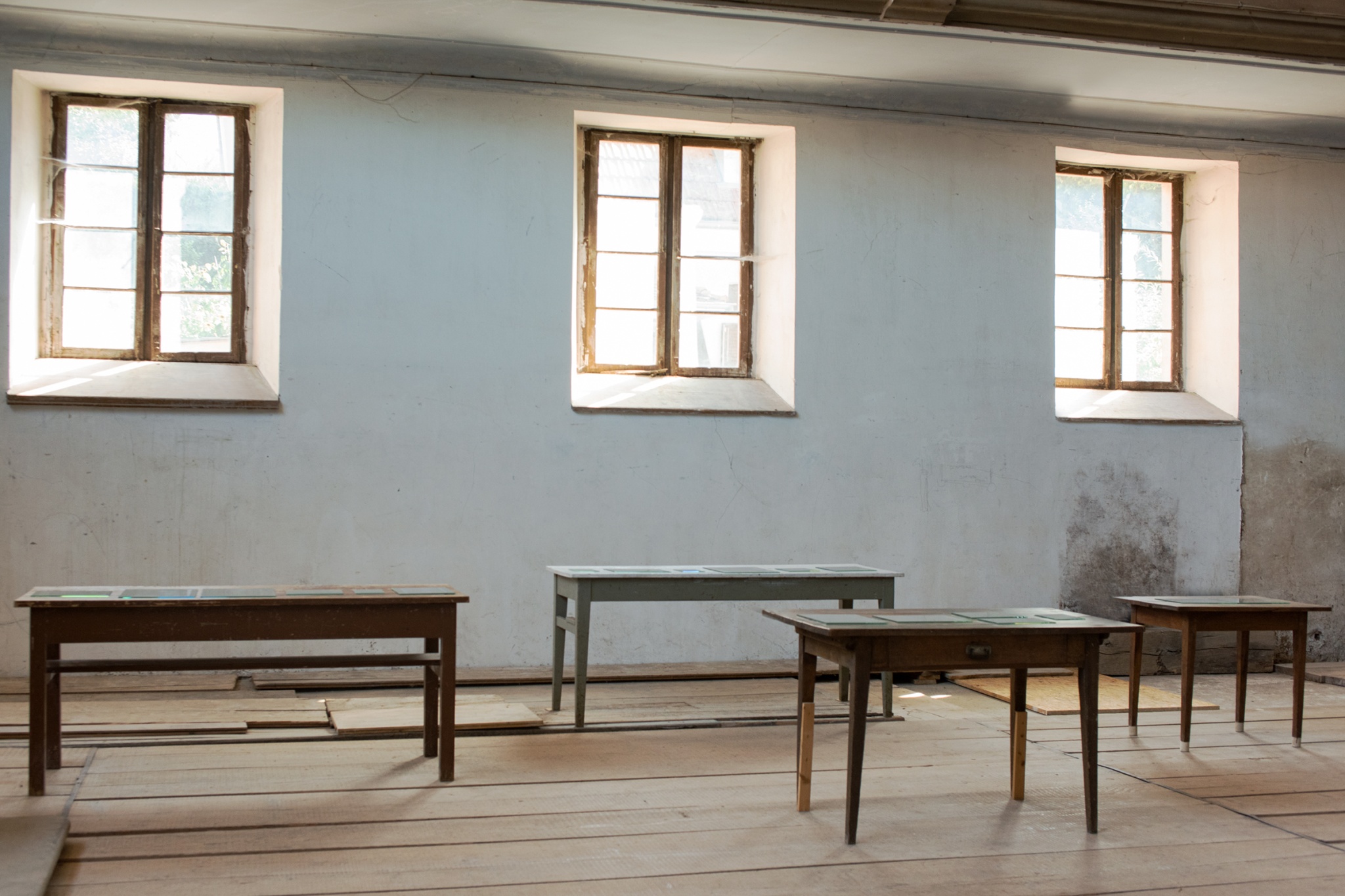
Detail view, Durchfluten, in der Gruppenausstellung, Flow Edition, Ancienne Synagogue Hégenheim, 2023
Detail view, Durchfluten, in der Gruppenausstellung, Flow Edition, Ancienne Synagogue Hégenheim, 2023
Exhibition view, Durchfluten, in der Gruppenausstellung, Flow Edition, Ancienne Synagogue Hégenheim, 2023
Detail view, Durchfluten, in der Gruppenausstellung, Flow Edition, Ancienne Synagogue Hégenheim, 2023
Detail view, Durchfluten, in der Gruppenausstellung, Flow Edition, Ancienne Synagogue Hégenheim, 2023
Audio piece + Exhibition view, Durchfluten, in der Gruppenausstellung, Flow Edition, Ancienne Synagogue Hégenheim, 2023
Exhibition view, Durchfluten, in der Gruppenausstellung, Flow Edition, Ancienne Synagogue Hégenheim, 2023
Photogramm on Baryt Paper, behind Glas, variabel sizes:
30.5 x 40.6 cm; 24 x 30.5 cm, 17.8 x 24 cm, 12.7x 17.8 cm
In der Installation stehen vier abgenutzte Holztische, welche die Künstlerin vor Ort in der Synagoge gefunden hat. Sie stehen in einer Gruppe, wie in einem Archiv oder einer Bibliothek. Auf den Tischen liegen Abbilder von amtlichen Dokumenten, ausgeschnitten und unter Glasplatten platziert.
Für die Arbeit «Durchfluten» hat Françoise Caraco das Recherchematerial, welche sie in verschiedenen Archiven gefunden hat, auf Fotopapier gelegt und durchleuchtet. Auf den entstandenen Fotogrammen heben sich die spärlichen Überlieferungen zu ihrer Familiengeschichte ab wie Licht vom Dunkel.
Der Ausgangspunkt der Recherche zu ihrer Familiengeschichte, verbindet Françoise Caraco spezifisch mit dem Ort Hegenheim. Ihr Urgrossonkel, eingewanderter Jude aus Konstantinopel, war einmal mit einer Jüdin aus Hegenheim verheiratet. Die Spuren dieser Familiengeschichte, sowie des gemeinsamen Sohnes Robert Caraco führten unter anderem nach Basel, Zürich, Frankreich, sowie nach Buchenwald, Natzweiler, Dachau und wieder zurück. Ihre Fundstücke - zu Geburt, Aufenthalt, Heirat, Einbürgerung oder Streitigkeiten, Inventare, Listen - was sie über ein persönliches Schicksal verraten oder eben auch nicht zu sagen vermögen, beinhalten jedoch auch immer Leerstellen. Diese Leerstellen zeichnet Françoise Caraco mit eigenen Fragen nach und verwebt sie mit dem Archivmaterial zu einer Geschichte. Diese können Besuchende als Audiospur auf einem Stuhl sitzend und durch das grosse Fenster an der Stirnseite des Raumes blickend hören. Hörend empfinden wir den Weg der Künstlerin und ihrer Recherchen nach, begeben uns auf eine Zeitreise in unterschiedliche Welten und holen durch das Fenster blickend, das Draussen in Gedanken in den Raum hinein.
Seit einigen Jahren beschäftigt sich Françoise Caraco in ihren ortsspezifischen Installationen mit der eigenen Familiengeschichte. Dabei nimmt sie wiederholt die hinterlassenen Notizen ihres Grossvaters als Grundlage und sucht durch die Kunst, die Lücken zu füllen.
Text: Patricia Hujinen
Audio piece, Durchfluten, 15' 18'', 2023
Spoken by Alma Caraco
 April 2023
April 2023Zofinger Luft
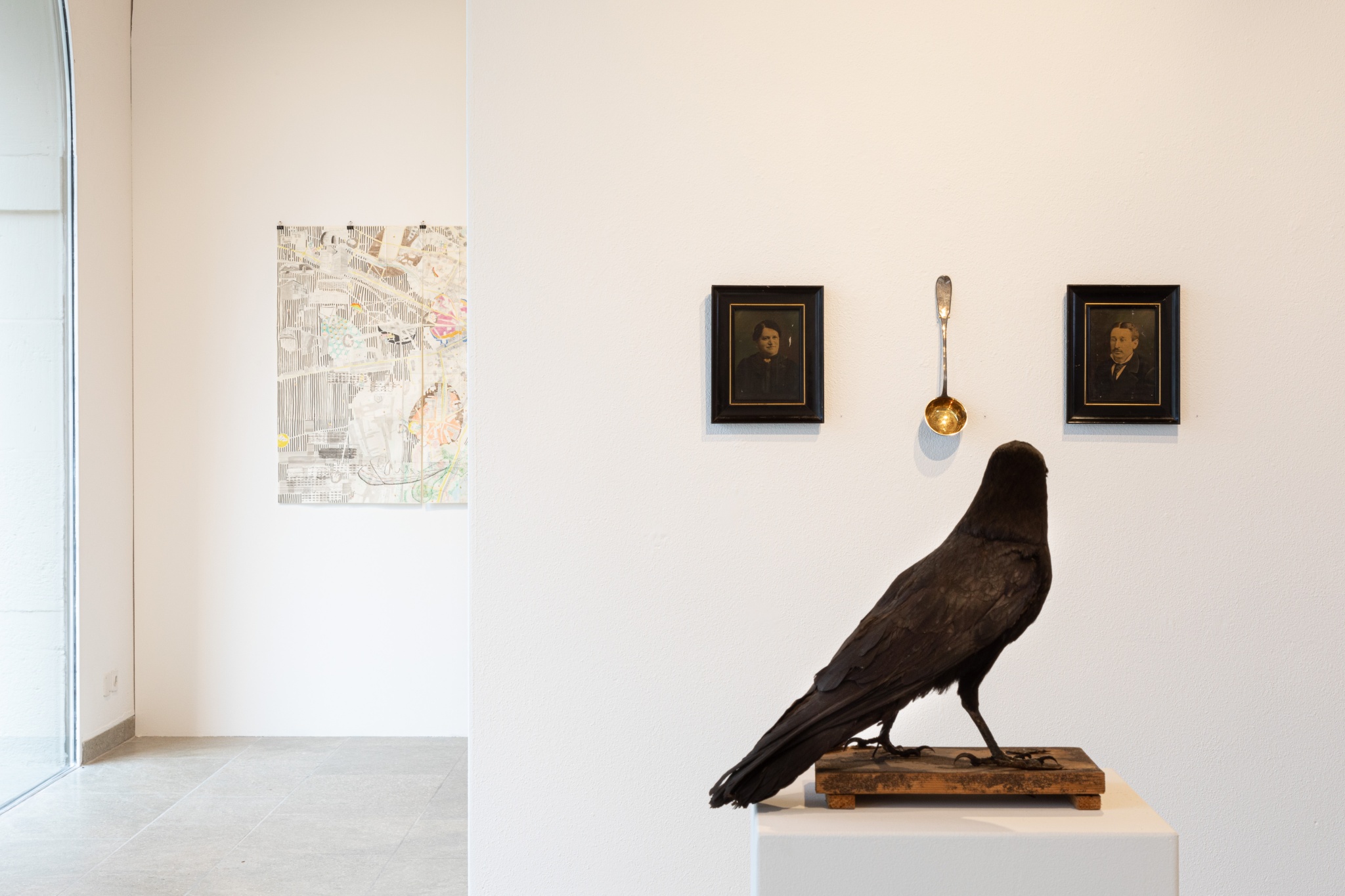
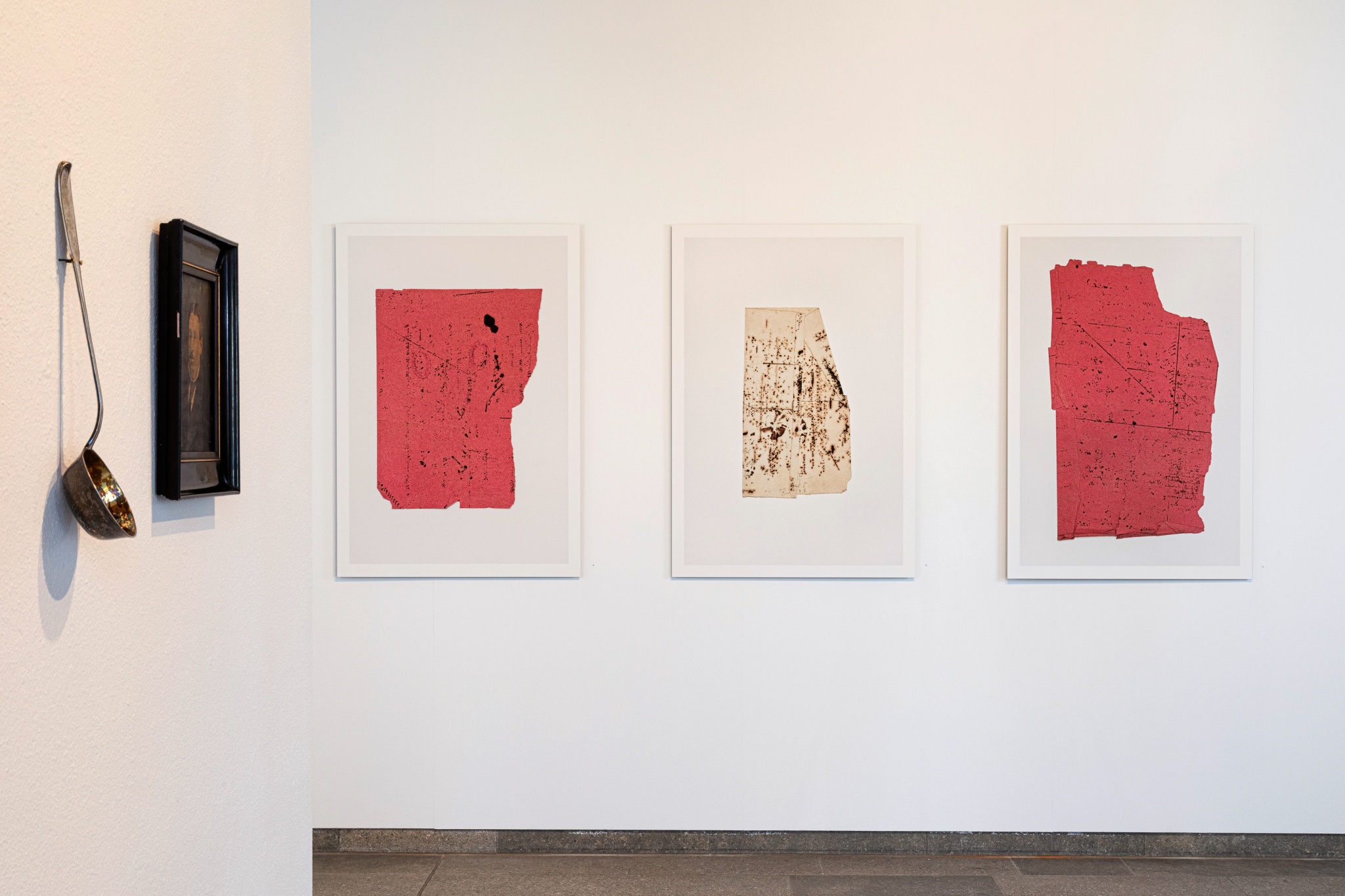






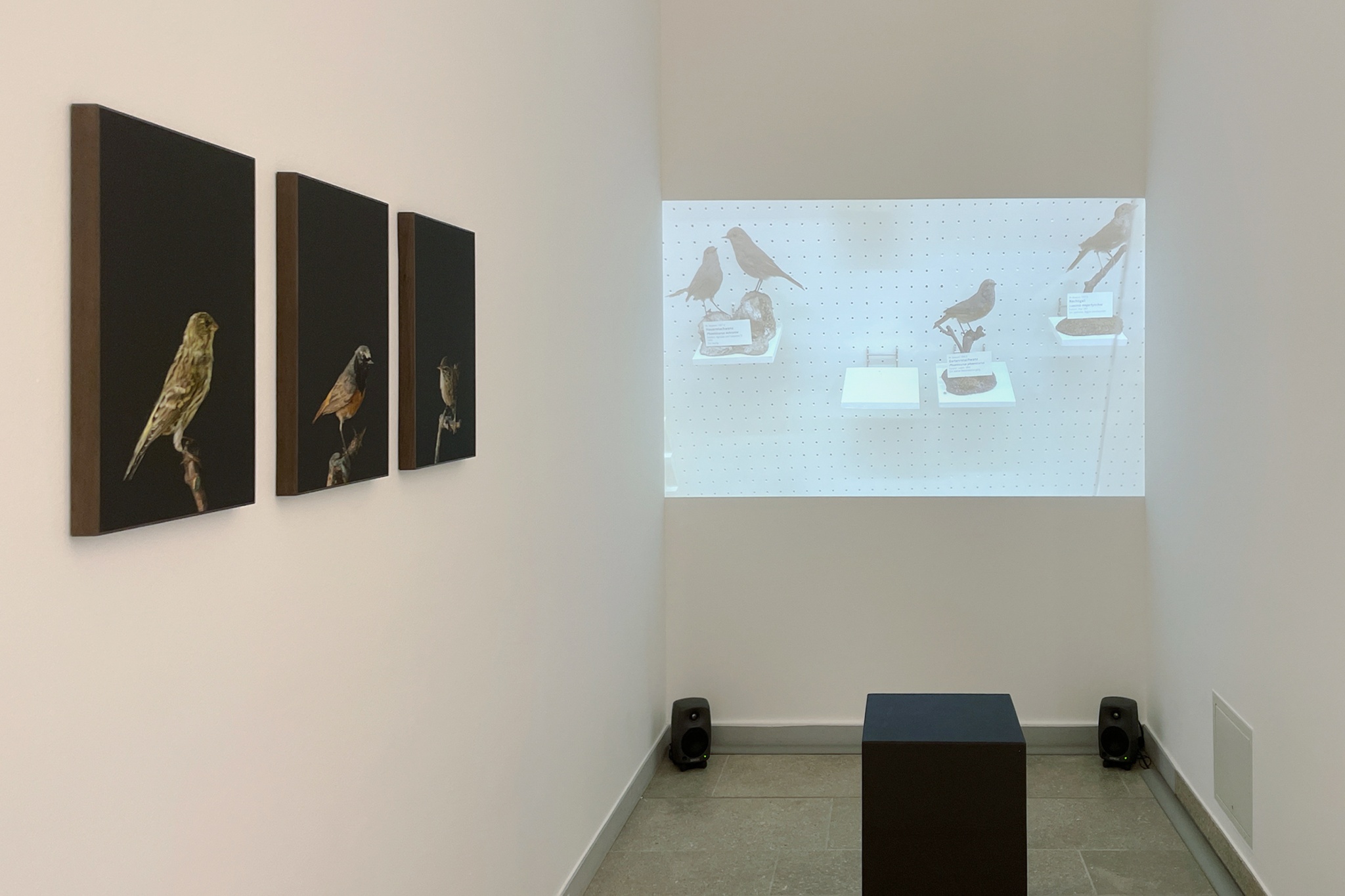
Exhibition view, Zofinger Luft, in the group exhibition, Mindmapping Art, Kunsthaus, Zofingen, 2023, Photo: Rachel Bühlmann
Exhibition view, Zofinger Luft, in the group exhibition, Mindmapping Art, Kunsthaus, Zofingen, 2023, Photo: Rachel Bühlmann
Exhibition view, Zofinger Luft, in the group exhibition, Mindmapping Art, Kunsthaus, Zofingen, 2023
Exhibition view, Zofinger Luft, in the group exhibition, Mindmapping Art, Kunsthaus, Zofingen, 2023
Exhibition view, Zofinger Luft, in the group exhibition, Mindmapping Art, Kunsthaus, Zofingen, 2023
Detail view, Zofinger Luft, in the group exhibition, Mindmapping Art, Kunsthaus, Zofingen, 2023
Exhibition view, Zofinger Luft, in the group exhibition, Mindmapping Art, Kunsthaus, Zofingen, 2023
Exhibition view, Zofinger Luft, in the group exhibition, Mindmapping Art, Kunsthaus, Zofingen, 2023
Exhibition view, Zofinger Luft, in the group exhibition, Mindmapping Art, Kunsthaus, Zofingen, 2023
Fotografien: Inkjetdruck auf Innovapapier, 118 x 80 cm, 60 x 40 cm, 87 x 60 cm, 45 x 30 cm
Video: HD 16:9, 1920 x 1080, Farbe, 9:52
Besucherinnen und Besucher werden von der vielteiligen Installation von Françoise Caraco empfangen, die sich über zwei Stockwerke verteilt. Caracos Installation mit dem Titel: ZOFINGER LUFT ist eine Auseinandersetzung mit ihrer eigenen Familiengeschichte. Caraco recherchiert zum Leben ihrer Urgrossmutter Clara Bollag und deren Familie im Zusammenhang mit der Ortsgeschichte von Zofingen. Clara Bollag lebte seit ihrer Geburt 1884 mit ihrer Familie in Zofingen, bevor sie 1892 zum Ursprungsort ihrer Familie, nach Endingen zog. Auf den Spuren Clara Bollags besuchte Françoise Caraco die Bibliothek und das Stadtarchiv in Zofingen, recherchierte im Archiv des Turnvereins Zofingen, im Museum Zofingen und dessen historischen und naturhistorischen Abteilung und führte Gespräche mit Bewohner*innen. Sie suchte nach Spuren ihrer Vorfahren, die jüdischer Herkunft waren. Bei ihrer Recherche erfuhr die Künstlerin, dass Clara Bollags Vater Viehhändler gewesen war, damals eine der wenigen beruflichen Möglichkeiten für Juden. Seine Frau und er lebten mit der Familie an verschiedenen Adressen in der Oberstadt Zofingens. Bollags Viehstall befand sich an der Scheunengasse. Diese Informationen hat Françoise Caraco im Register der Einwohnerkontrolle Zofingen 1898, im Geburtsregister a II, 1883-1891, im Liegenschaftsverzeichnis der Gemeinde-Zofingen von 1886 oder im Steuerbuch der Gemeinde Zofingen 1892-1897 gefunden. Daraus lässt sich auf die Lebensumstände der Familie Bollag schliessen, doch ergibt sich kein Bild, wie ihre Urgrossmutter Clara in Zofingen lebte.
Was mochte die Familie von Clara Bollag 1892 zur Rückkehr nach Endingen bewogen haben? Wo und wie lebte Clara Bollag? Vieles bleibt unbeantwortet. Diese fehlenden Informationen zeichnet Françoise Caraco anhand von bildlichen Leerstellen in der Installation ZOFINGER LUFT nach. Sie visualisiert die Leerstellen einerseits mit Löschblättern welche sie in den Büchern des Stadtarchivs Zofingen gefunden hat, andererseits mit präparierten Vögeln, die in der Zeit von Clara Bollag in Zofingen gelebt haben und die sie fotografiert oder mit unbelichteten Fotonegativplatten, aus dem Nachlass eines Zofinger Fotografen, welche thematisch in Zusammenhang mit der Geschichte der Familie stehen. Finale der Installation bildet das Videowerk: ZOFINGER LUFT, 1878 – 1892, das in bewegtem Bild und gesprochenem Wort die künstlerische Recherche von Françoise Caraco zu Clara Bollag vereint.
Text: Eva Bigler
 December 2022
December 2022Hidden Istanbul
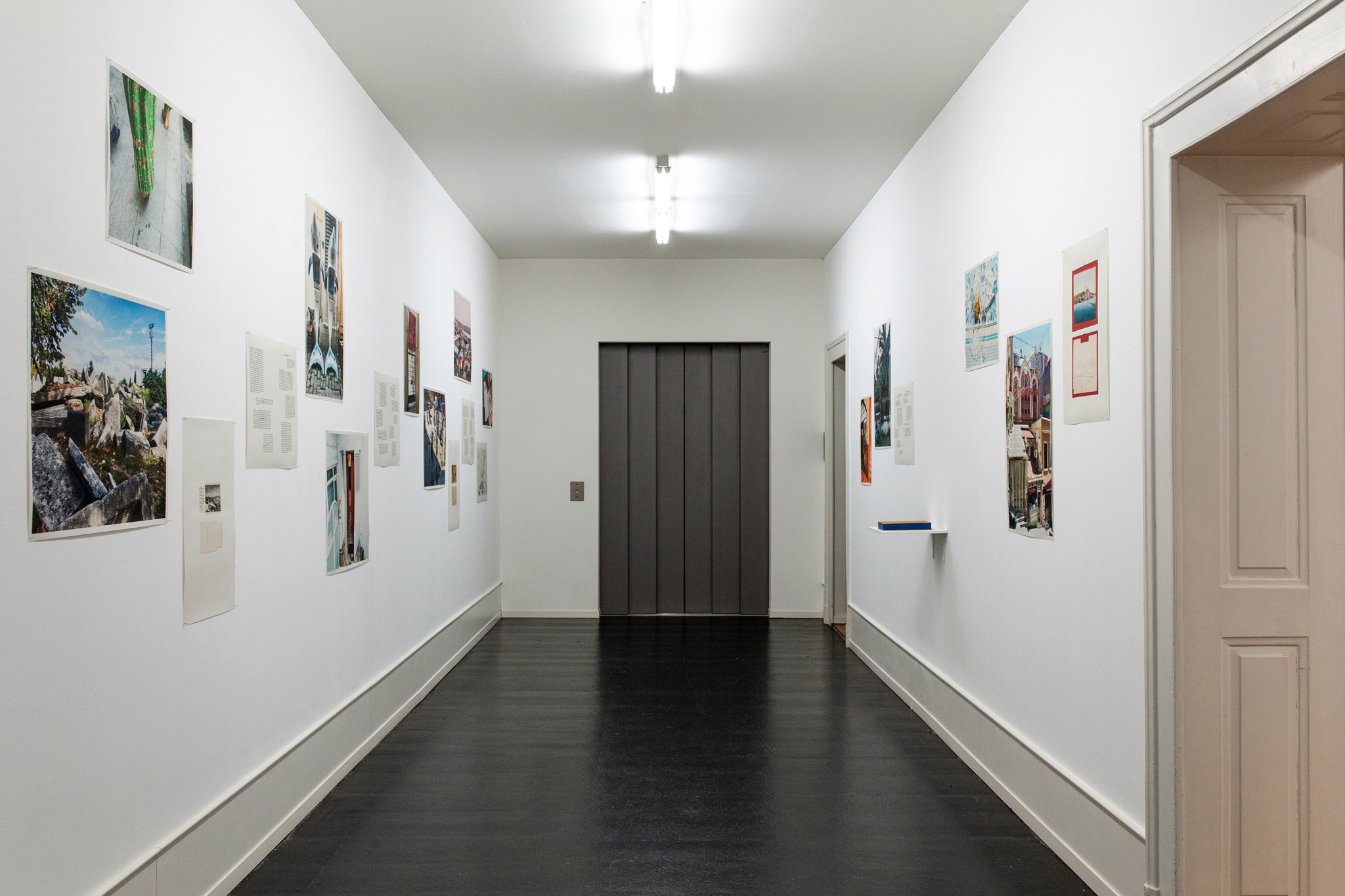
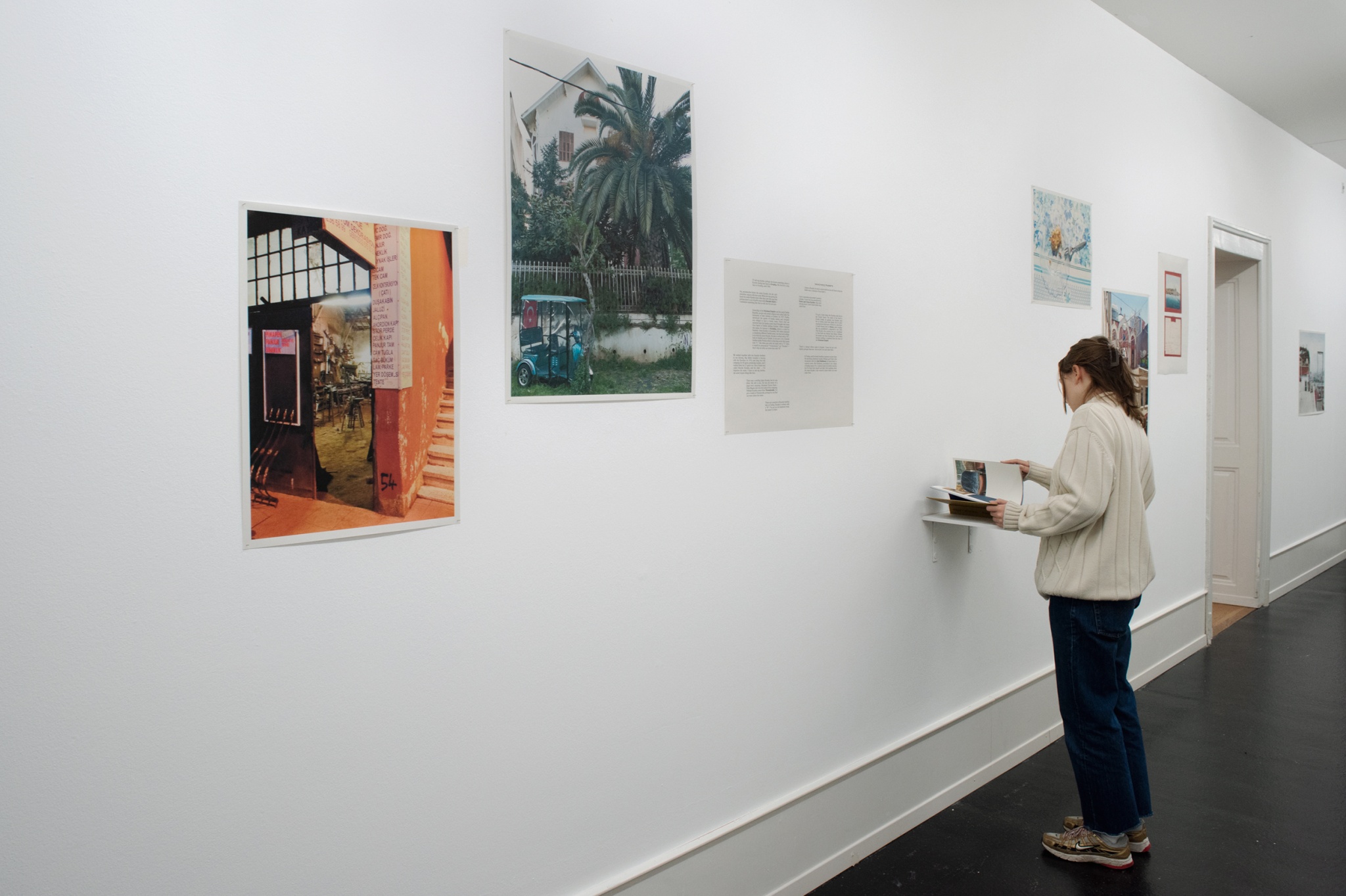


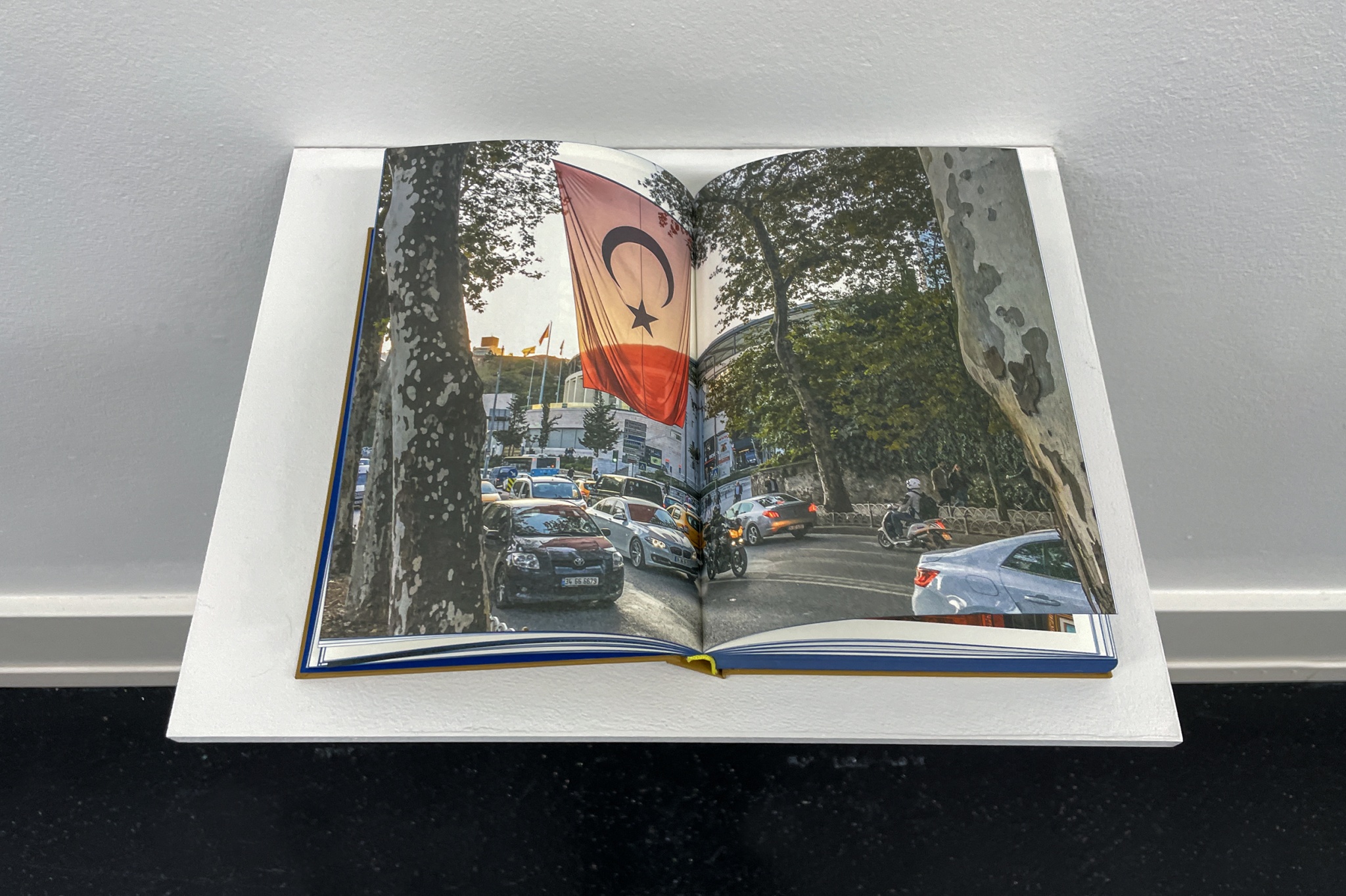
exhibition view, Hidden Istanbul, in the group exhibition, Prix Photoforum 2022, Pasquart Photoforum, Biel, 2022, Foto: Aline Bovard Rudaz
exhibition view, Hidden Istanbul, in the group exhibition, Prix Photoforum 2022, Pasquart Photoforum, Biel, 2022
exhibition view, Hidden Istanbul, in the group exhibition, Prix Photoforum 2022, Pasquart Photoforum, Biel, 2022
detail view, Hidden Istanbul, in the group exhibition, Prix Photoforum 2022, Pasquart Photoforum, Biel, 2022, Foto: Aline Bovard Rudaz
detail view, book: Hidden Istanbul, in the group exhibition, Prix Photoforum 2022, Pasquart Photoforum, Biel, 2022,
Fotografien: Inkjetprint auf gmg ProofMedia Newspaper 76g, Grösse: 77.3 x 58 cm oder 43.5 x 58 cm
Buch: Hidden Istanbul, APE#194, Art Paper Editions, Belgien, 2021
How can something that is concealed be represented, be shown? This is precisely what Françoise Caraco has tried to undertake in the current book ‘Hidden Istanbul’. On a quest to find her ancestors, Françoise Caraco travelled to Istanbul numerous times and talked to people who knew or had known a Caraco—or Karako—or at least remembered the name. This afforded her a unique glimpse of the culture of the Sephardic Jews, who have inhabited the Turkish metropolis for centuries but remain unseen by most eyes.
In ‘Hidden Istanbul’ Françoise Caraco sensitively weaves family memories with her own contemporary photographs of her journey and researches, intermingled with various voices from Istanbul’s Jewish community. The result is a rich and nuanced portrait of a vanishing past and a still-vibrant present of the city from the perspective of a largely unknown segment of its population.
 September 2022
September 2022Gizli Istanbul / Hidden Istanbul
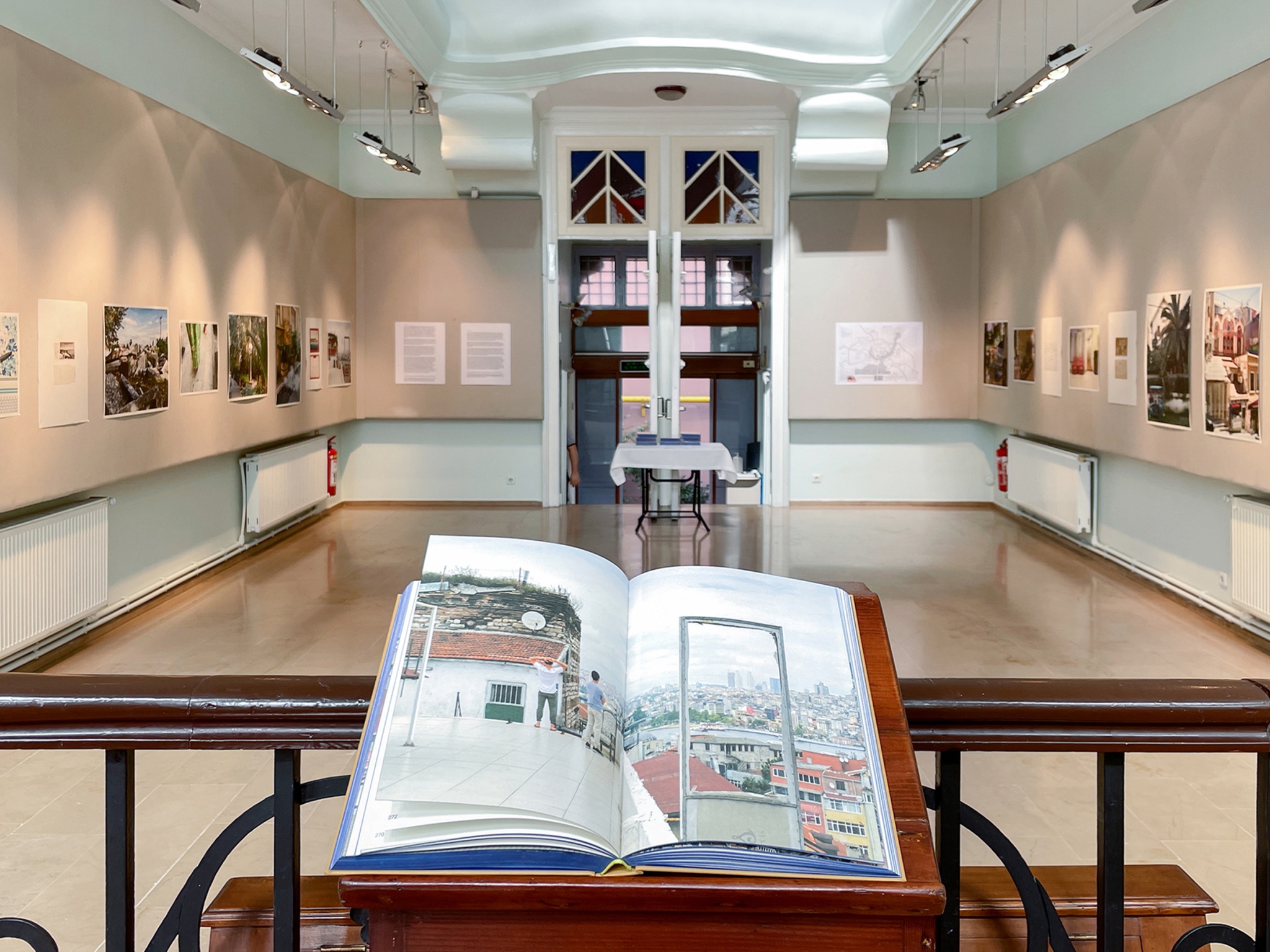
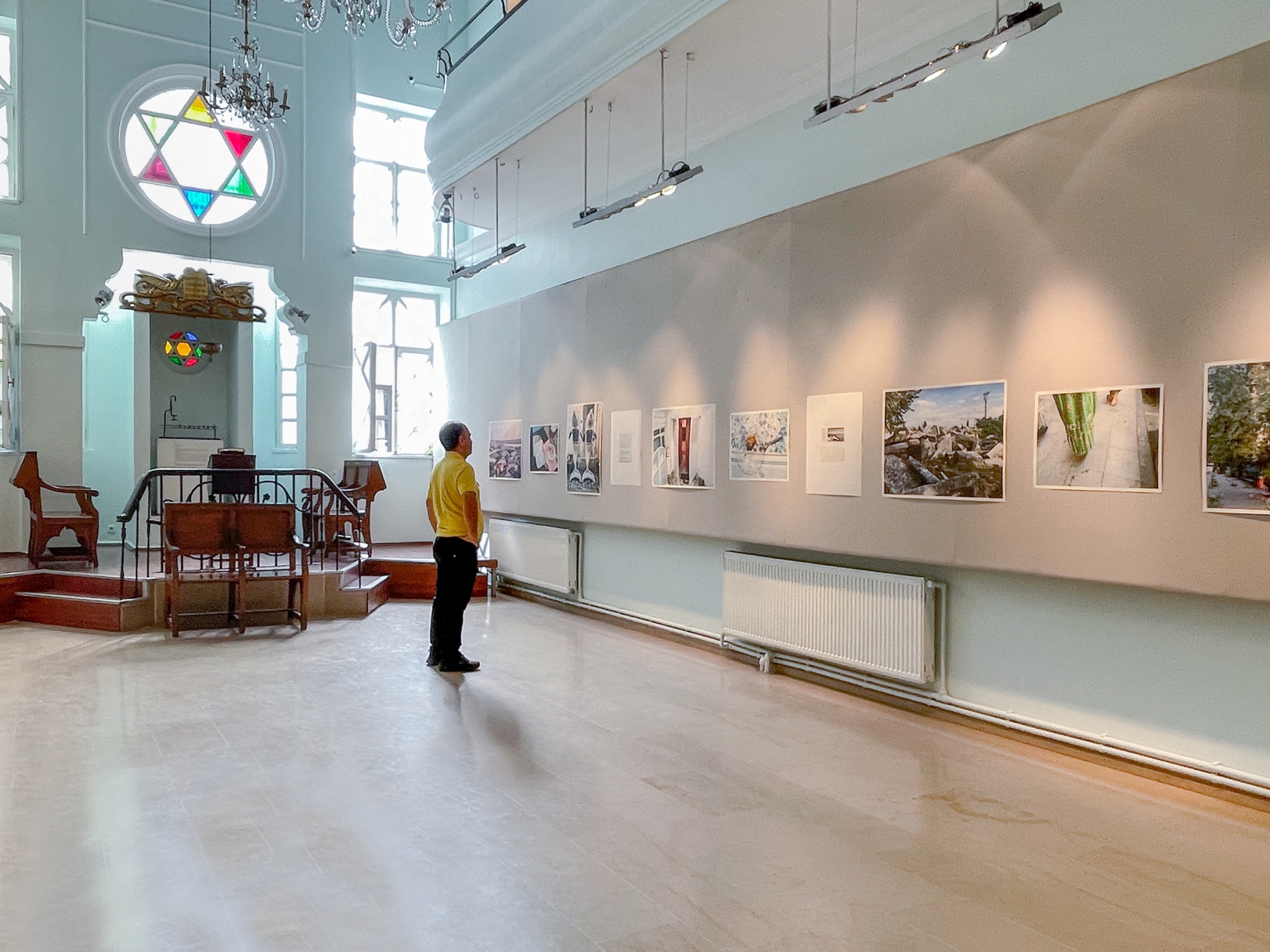





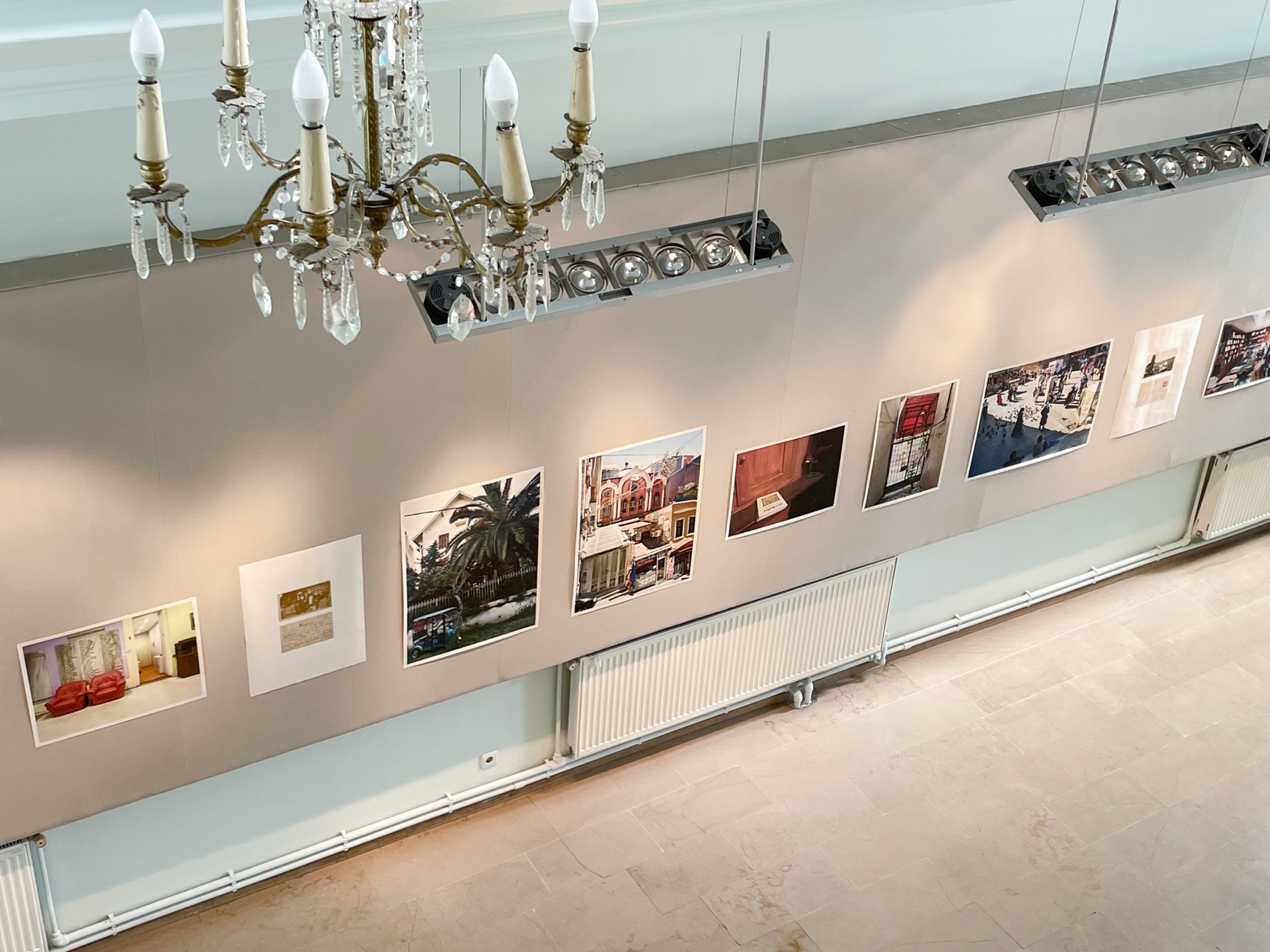
Exhibition view Gizli Istanbul / Hidden Istanbul, Schneidertempel Arts Center, Istanbul 2022
Exhibition view Gizli Istanbul / Hidden Istanbul, Schneidertempel Arts Center, Istanbul 2022
Exhibition view Gizli Istanbul / Hidden Istanbul, Schneidertempel Arts Center, Istanbul 2022
Exhibition view Gizli Istanbul / Hidden Istanbul, Schneidertempel Arts Center, Istanbul 2022
Exhibition view Gizli Istanbul / Hidden Istanbul, Schneidertempel Arts Center, Istanbul 2022
Exhibition view Gizli Istanbul / Hidden Istanbul, Schneidertempel Arts Center, Istanbul 2022
Exhibition view Gizli Istanbul / Hidden Istanbul, Schneidertempel Arts Center, Istanbul 2022
Inkjetprint auf gmg ProofMedia Newspaper 76g, 77.3 x 58 cm oder 43.5 x 58 cm
Book: Hidden Istanbul, APE#194, Art Paper Editions, Belgien, 2021
The book HIDDEN ISTANBUL serves as the basis for the exhibition at the Schneidertempel Arts Center. Photographs and images of archival material are printed in inkjet on thin newsprint and hung on the walls in equal measure as a kind of documentary tracing of Istanbul Jewish life. The statements from the interviewees can be found in the book.
How can something that is concealed be represented, be shown? This is precisely what Françoise Caraco has tried to undertake in the current book HIDDEN ISTANBUL. On a quest to find her ancestors, Françoise Caraco travelled to Istanbul numerous times and talked to people who knew or had known a Caraco—or Karako—or at least remembered the name. This afforded her a unique glimpse of the culture of the Sephardic Jews, who have inhabited the Turkish metropolis for centuries but remain unseen by most eyes. In ‘Hidden Istanbul’ Françoise Caraco sensitively weaves family memories with her own contemporary photographs of her journey and researches, intermingled with various voices from Istanbul’s Jewish community. The result is a rich and nuanced portrait of a vanishing past and a still-vibrant present of the city from the perspective of a largely unknown segment of its population.
 December 2021
December 2021Hidden Istanbul

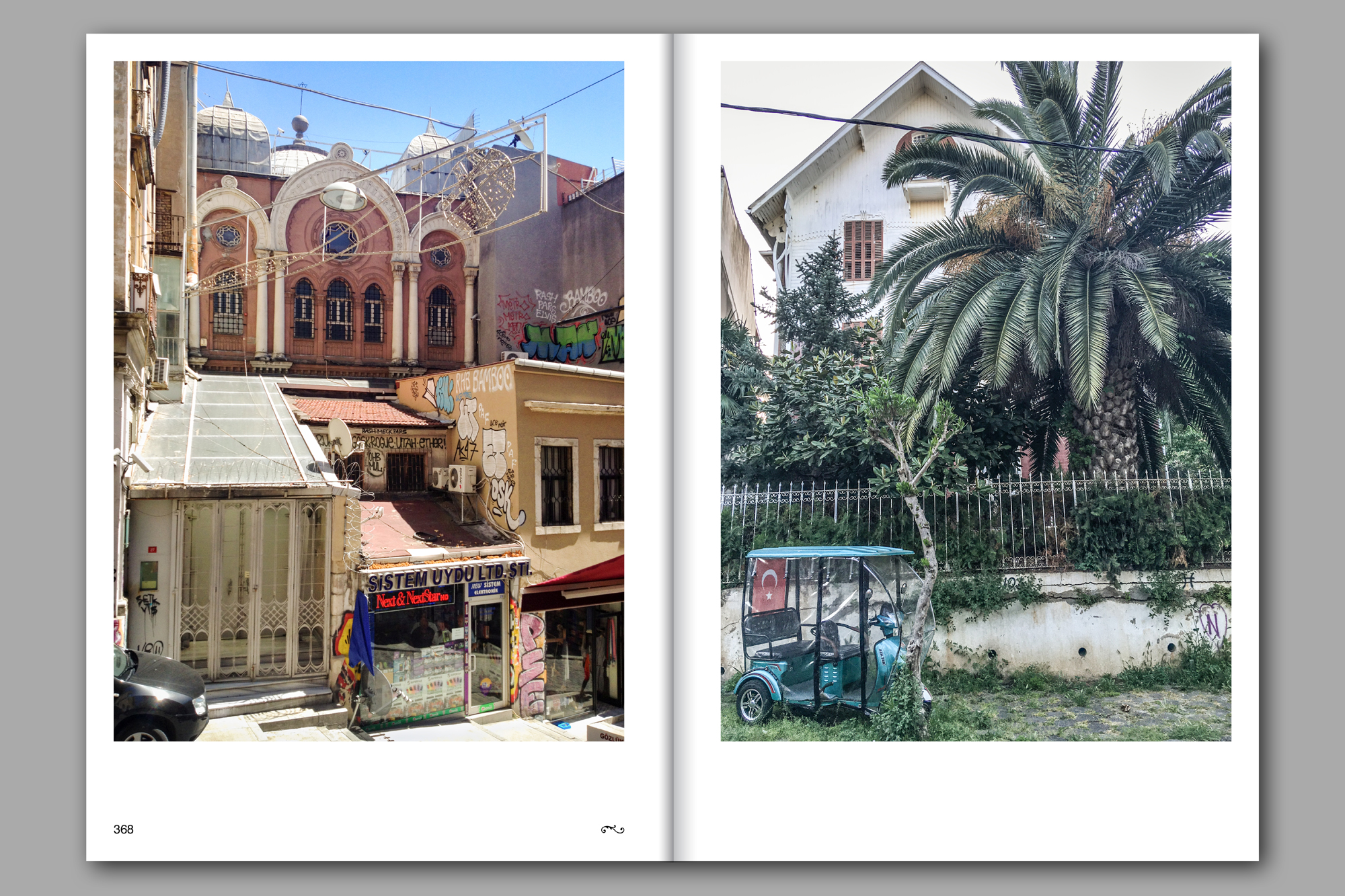






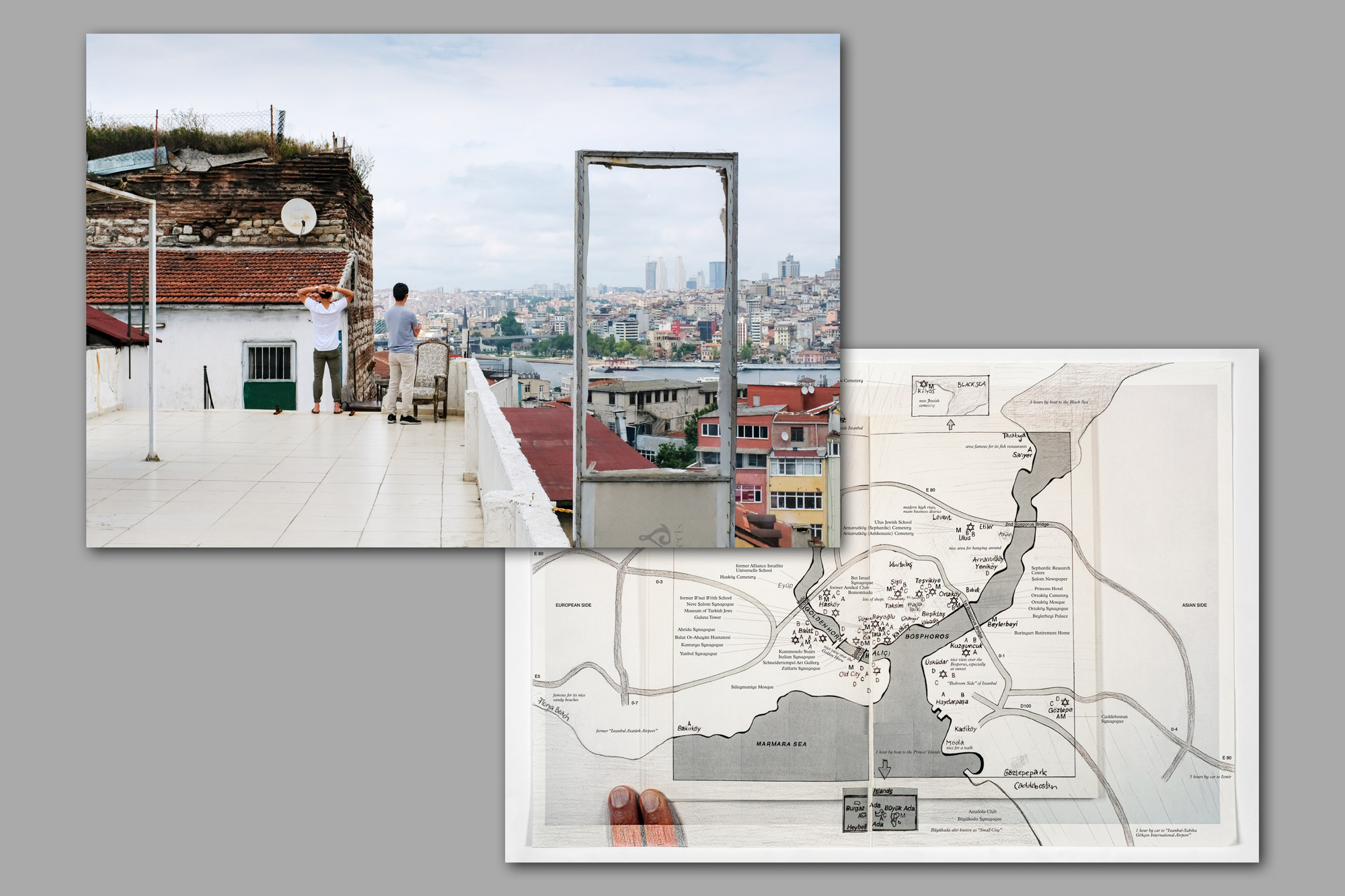
Hidden Istanbul, APE#194, Art Paper Editions, Belgien, 2021
Hidden Istanbul, APE#194, Art Paper Editions, Belgien, 2021
Hidden Istanbul, APE#194, Art Paper Editions, Belgien, 2021
Hidden Istanbul, APE#194, Art Paper Editions, Belgien, 2021
Hidden Istanbul, APE#194, Art Paper Editions, Belgien, 2021
Hidden Istanbul, APE#194, Art Paper Editions, Belgien, 2021
Hidden Istanbul, APE#194, Art Paper Editions, Belgien, 2021
Hidden Istanbul, APE#194, Art Paper Editions, Belgien, 2021
Hidden Istanbul, APE#194, Poster, Art Paper Editions, Belgien, 2021
Hardcover 17 × 24 cm, 404 Seiten, 263 Farbfotografien, Language: English, ISBN 9789493146716
Design & Editing: Lien Van Leemput & Françoise Caraco
Design: Lien Van Leemput & Françoise Caraco for 6'56" Art Paper Editions, Belgien, 2021.
Each book comes with a two-sided poster.
How can something that is concealed be represented, be shown? This is precisely what Françoise Caraco has tried to undertake in the current book Hidden Istanbul. On a quest to find her ancestors, Françoise Caraco travelled to Istanbul numerous times and talked to people who knew or had known a Caraco—or Karako—or at least remembered the name. This afforded her a unique glimpse of the culture of the Sephardic Jews, who have inhabited the Turkish metropolis for centuries but remain unseen by most eyes.
In Hidden Istanbul Françoise Caraco sensitively weaves family memories with her own contemporary photographs of her journey and researches, intermingled with various voices from Istanbul’s Jewish community. The result is a rich and nuanced portrait of a vanishing past and a still-vibrant present of the city from the perspective of a largely unknown segment of its population.
 March 2021
March 2021Trolley Suitcase
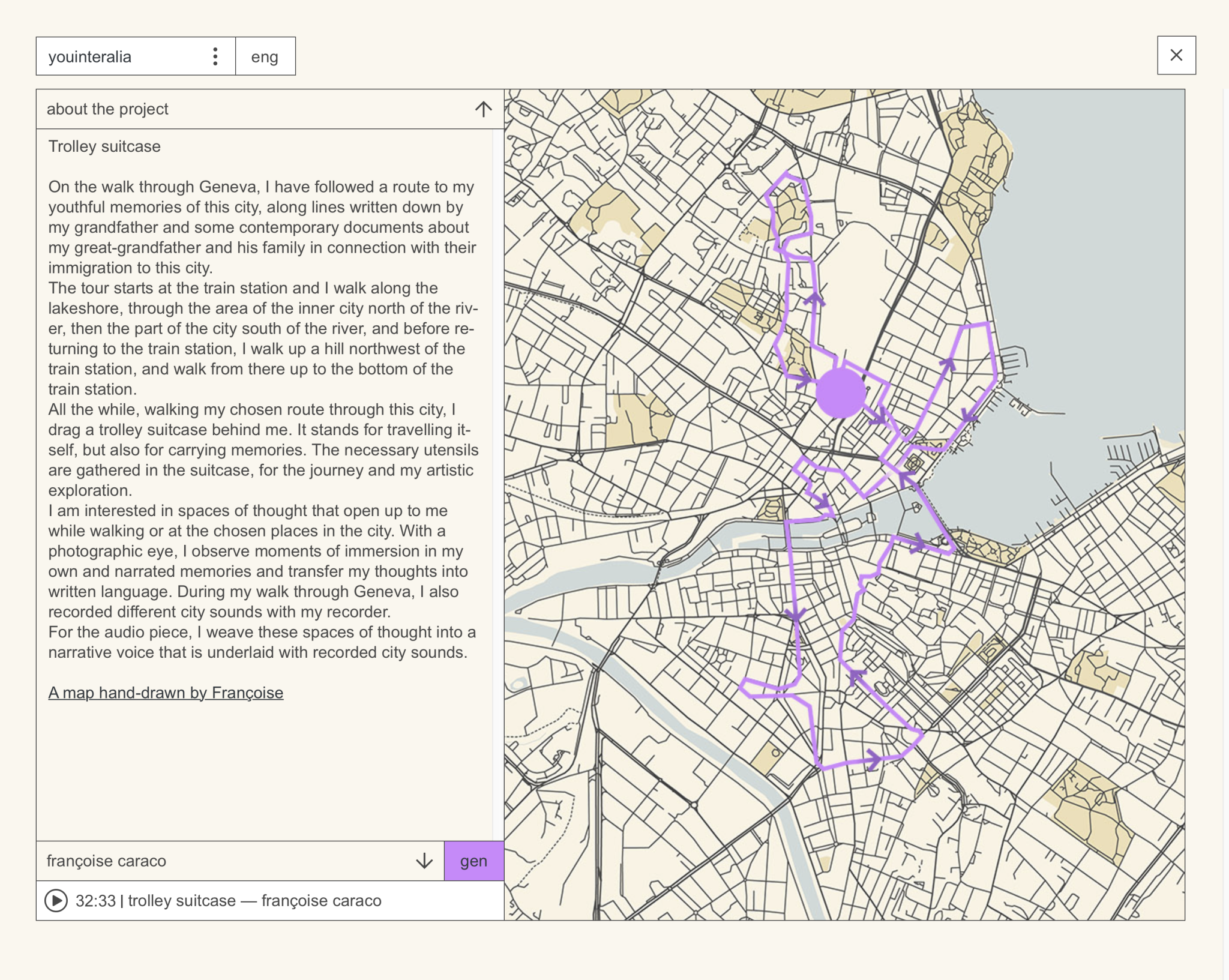


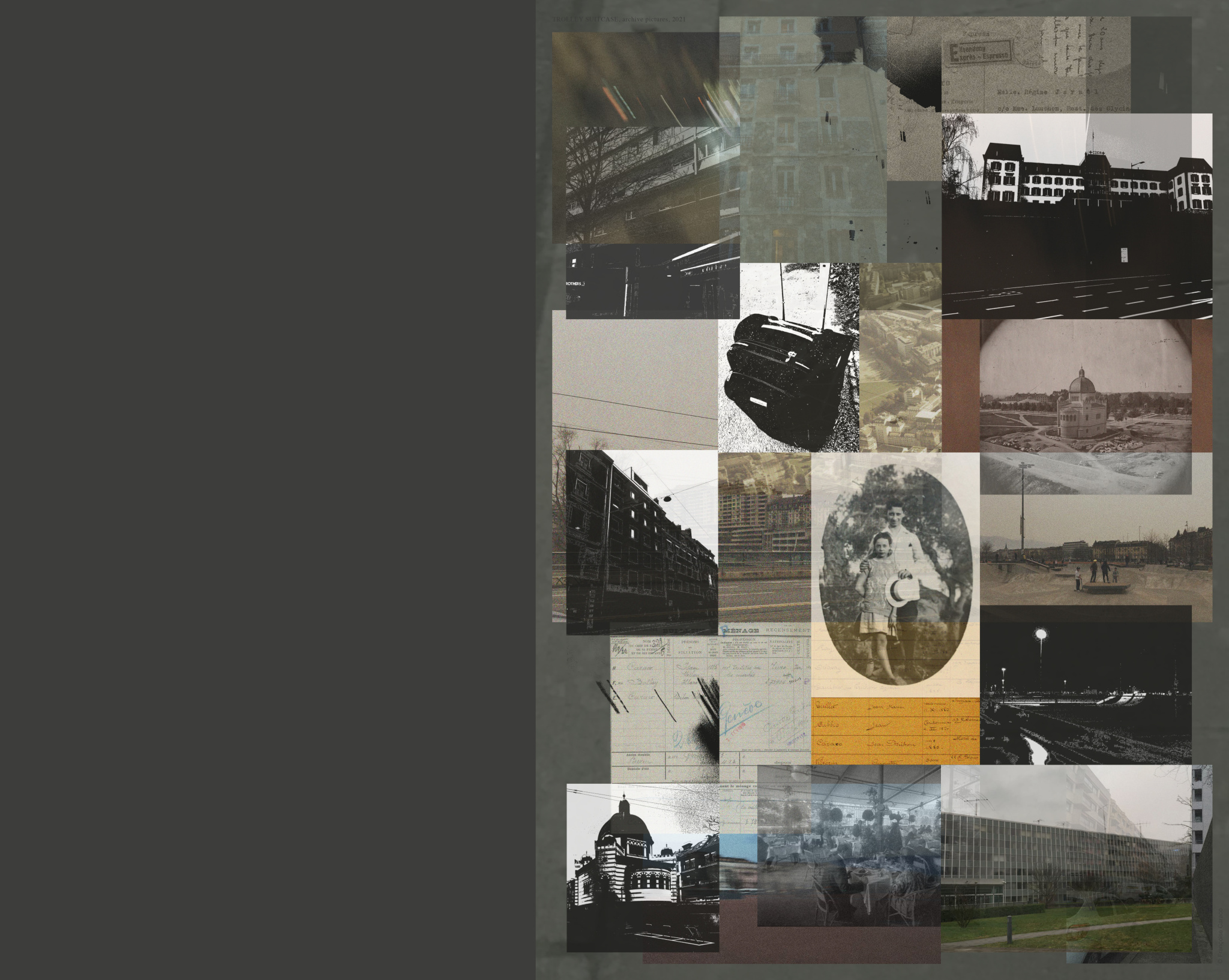
Trolley Suitcase, audio piece about walking and writing, website view from the art-project, you, inter alia, St. Petersburg – Geneva, 2021
Trolley Suitcase, audio piece about walking and writing, website view from the art-project, you, inter alia, St. Petersburg – Geneva, 2021
Trolley Suitcase, audio piece about walking and writing, detail view from the art-project, you, inter alia, St. Petersburg – Geneva, 2021
Trolley Suitcase, audio piece about walking and writing, detail view from the art-project, you, inter alia, St. Petersburg – Geneva, 2021
Audio piece: 32‘ 33‘‘, Spoken by Alma Caraco
Trolley Suitcase, about walking and writing, from the art-project, you, inter alia, St. Petersburg – Geneva, 2021
On the walk through Geneva, I have followed a route to my youthful memories of this city, along lines written down by my grandfather and some contemporary documents about my great-grandfather and his family in connection with their immigration to this city.
The tour starts at the train station and I walk along the lakeshore, through the area of the inner city north of the river, then the part of the city south of the river, and before returning to the train station, I walk up a hill northwest of the train station, and walk from there up to the bottom of the train station.
All the while, walking my chosen route through this city, I drag a trolley suitcase behind me. It stands for travelling itself, but also for carrying memories. The necessary utensils are gathered in the suitcase, for the journey and my artistic exploration.
I am interested in spaces of thought that open up to me while walking or at the chosen places in the city. With a photographic eye, I observe moments of immersion in my own and narrated memories and transfer my thoughts into written language. During my walk through Geneva, I also recorded different city sounds with my recorder.
For the audio piece, I weave these spaces of thought into a narrative voice that is underlaid with recorded city sounds.
Trolley Suitcase is my contribution to the project on «You, inter alia», a web-based intervention by Alina Belishkina and Lera Mostovoya. «You, inter alia» explores space of the city and that of the text through practices of walking and writing, in St Petersburg and Geneva. http://youinteralia.com
 July 2020
July 2020Familienangelegenheit // Family affair


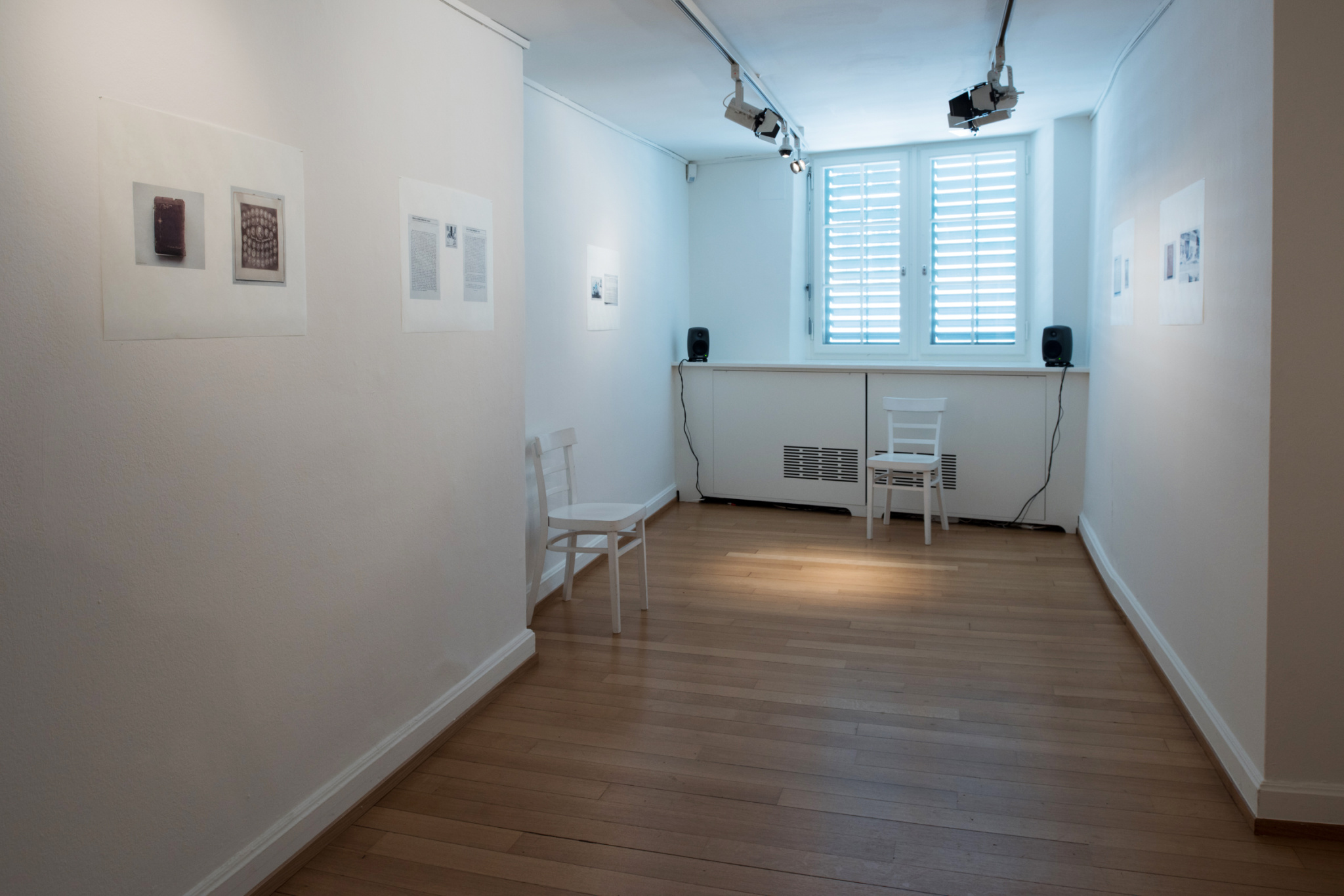
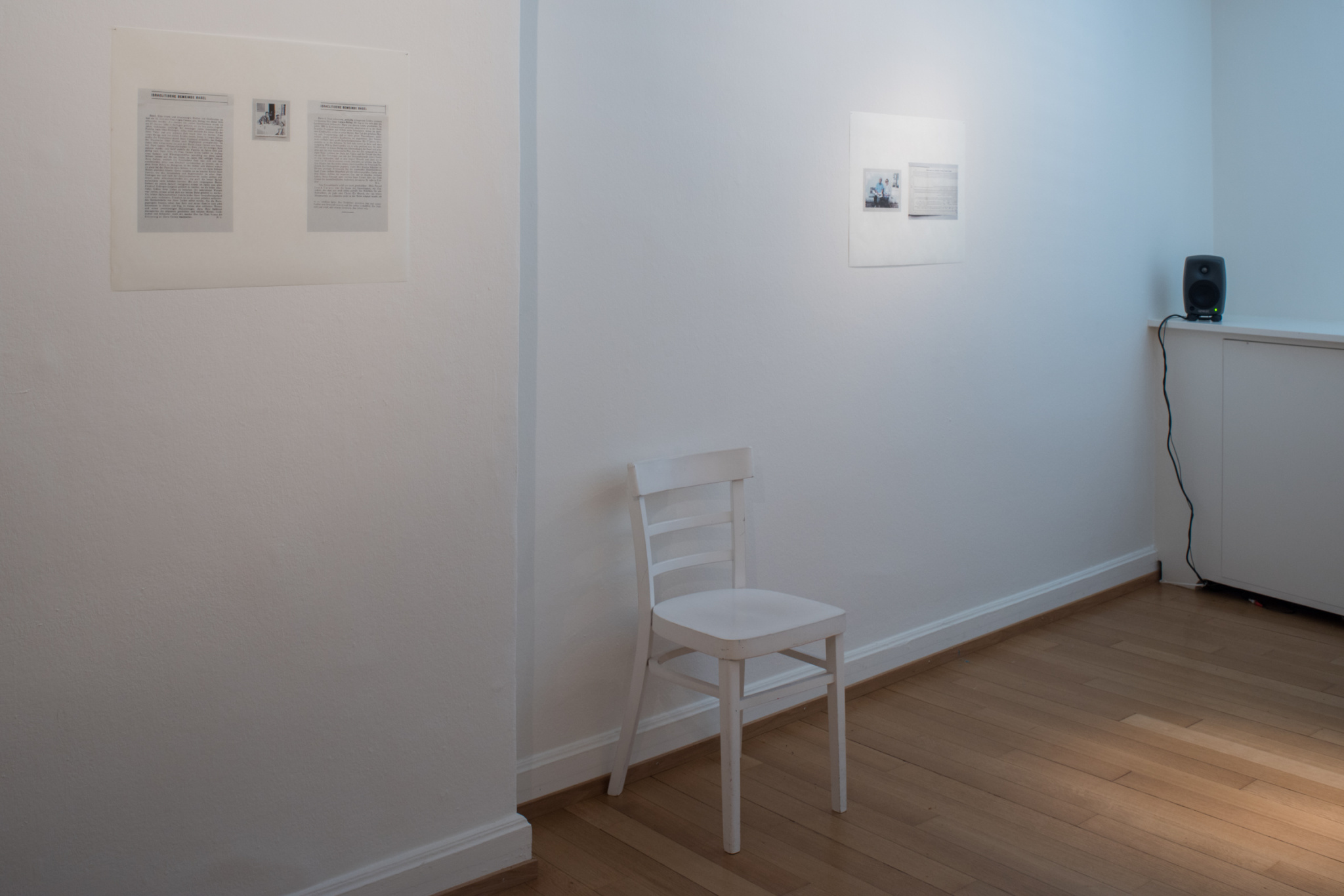
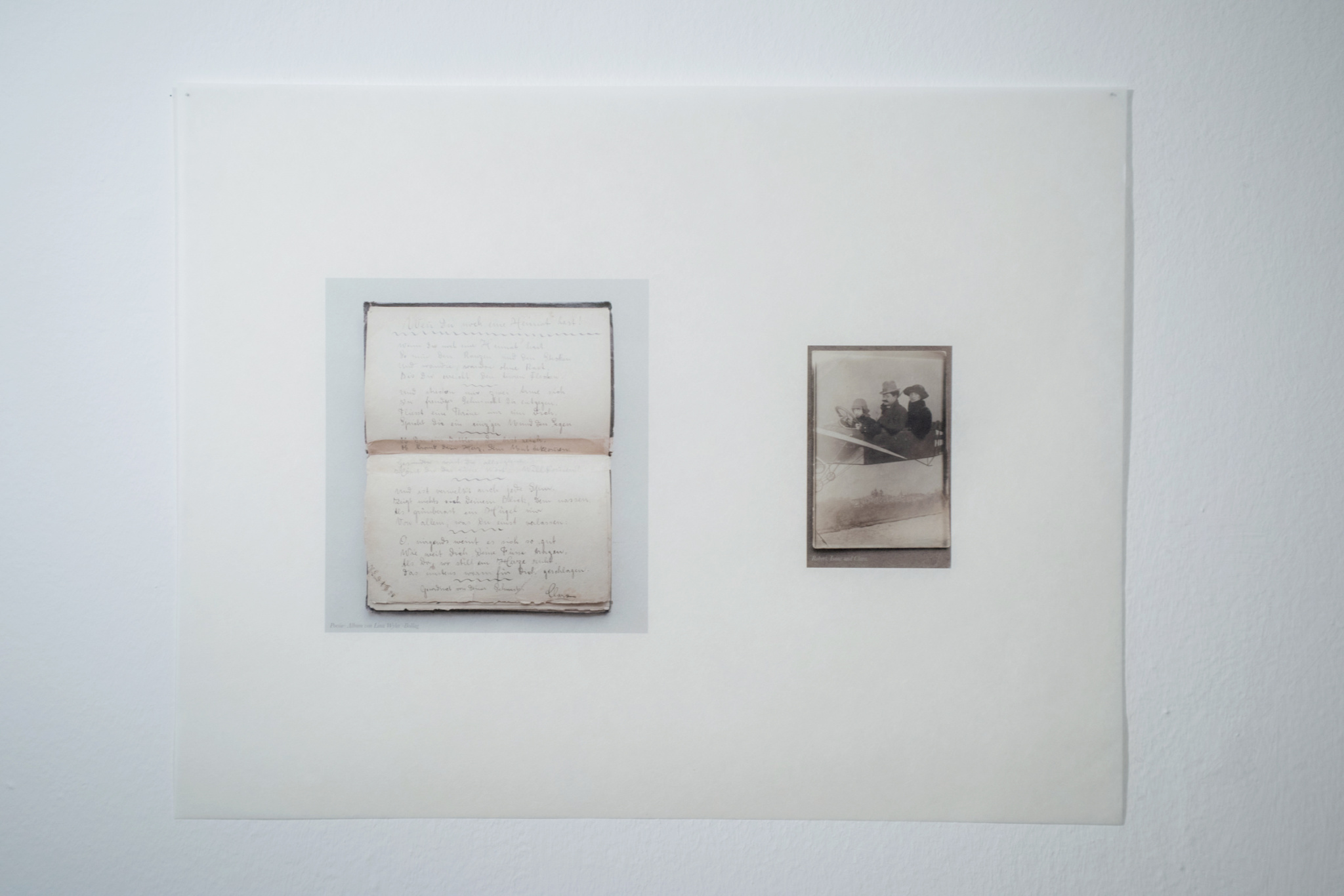

Exhibition view, Familienangelegenheit, Museum Strauhof, Zürich, 2020
Detail view, Familienangelegenheit, Museum Strauhof, Zürich, 2020
Exhibition view, Familienangelegenheit, Museum Strauhof, Zürich, 2020
Exhibition view, Familienangelegenheit, Museum Strauhof, Zürich, 2020
Detail view, Familienangelegenheit, Museum Strauhof, Zürich, 2020
Exhibition view, Familienangelegenheit, Museum Strauhof, Zürich, 2020
Audiofile, Familienangelegenheit – Ein Zwiegespräch, Strauhof, Zürich, 2020
Audiostück 23‘ 25“, gesprochen von Esther Becker
15 Farbfoto auf Bütenpapier 420 x 594 mm
Françoise Caraco befasst sich in ihren Arbeiten seit einigen Jahren mit ihrer Familiengeschich-te. Ihre jüngste Recherche hat sie ins Surbtal geführt, nach Endingen, einem ehemaligen «Judendorf». Im 18. und 19. Jahrhundert waren Endingen und das Nachbardorf Lengnau die einzi-gen Orte der Schweiz, in denen sich Juden niederlassen durften. Caracos Urgrossmutter Clara Bollag und weitere Familienmitglieder haben auf dem jüdischen Friedhof Endingens ihre letzte Ruhe gefunden. Aus gesammelten Gesprächssequenzen mit ihrem Vater und dessen Gros-scousine entwirft die Künstlerin ein Zwiegespräch. Caracos Audioarbeit verwebt anhand des Zwiegesprächs Momente des Alltags, der Freude und des Verlusts mit Sequenzen einer Radio-sendung, welche die Herkunft aus dem Surbtal umkreisen. An den Wänden versammelt die Künstlerin skizzenhafte Momentaufnahmen persönlichen Quellenmaterials aus dem Nachlass der Familien Caraco und Wyler und Ausschnitte aus Geschichtsbüchern zu Endingen. Geschichte wird bei Caraco zum fortwährenden, dialogischen Abgleich zwischen individueller und kollektiver Erinnerung.
 November 2017
November 2017Grossvaters Dokumente

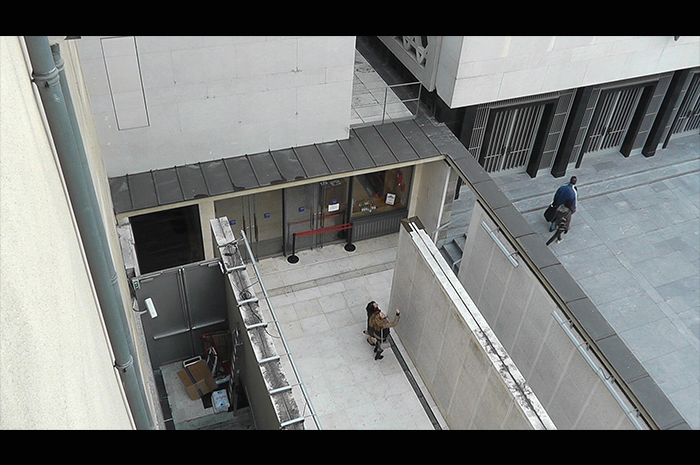
Exhibition view, Grossvaters Dokumente, in the group show, In the save hands of the artist, Projektraum M54, Basel 2017
Videostill, Grossvaters Dokumente
Part of the video, Grossvaters Dokumente
Video, HD 16:9, Zeitdauer 9‘ 54“, Loop, Farbe, Ton
Transkript, 148cm x 34cm
Archive sind private und kollektive Gedächtnisspeicher, die durch das Gezeigte zugleich auf das Fehlende hinweisen. Bei nachforschungen zu lückenhaften Familiengeschichte, sah Caraco im Archiv des Mémorial de la Shoah Dokumente verschollener jüdischer Verwandten ein. Bei der Dokumentation ihrer Recherche lässt sich die Künstlerin im Video – als Teil von Grossvaters Dokumente – in der Tradition der Romantiker in Rückenansicht aufnehmen, wodurch der Zuschauer selber in die Position der Künstlerin / Forscherin gerät. Anstelle einer erhaben Landschaft wird er bei Caraco mit einem Familienschicksal und einem abgründigen kapitel der Geschichte konfrontiert.
Text Ricarda Gerosa / Baharak Omidfard
 June 2017
June 2017Der Kaufmann Caraco
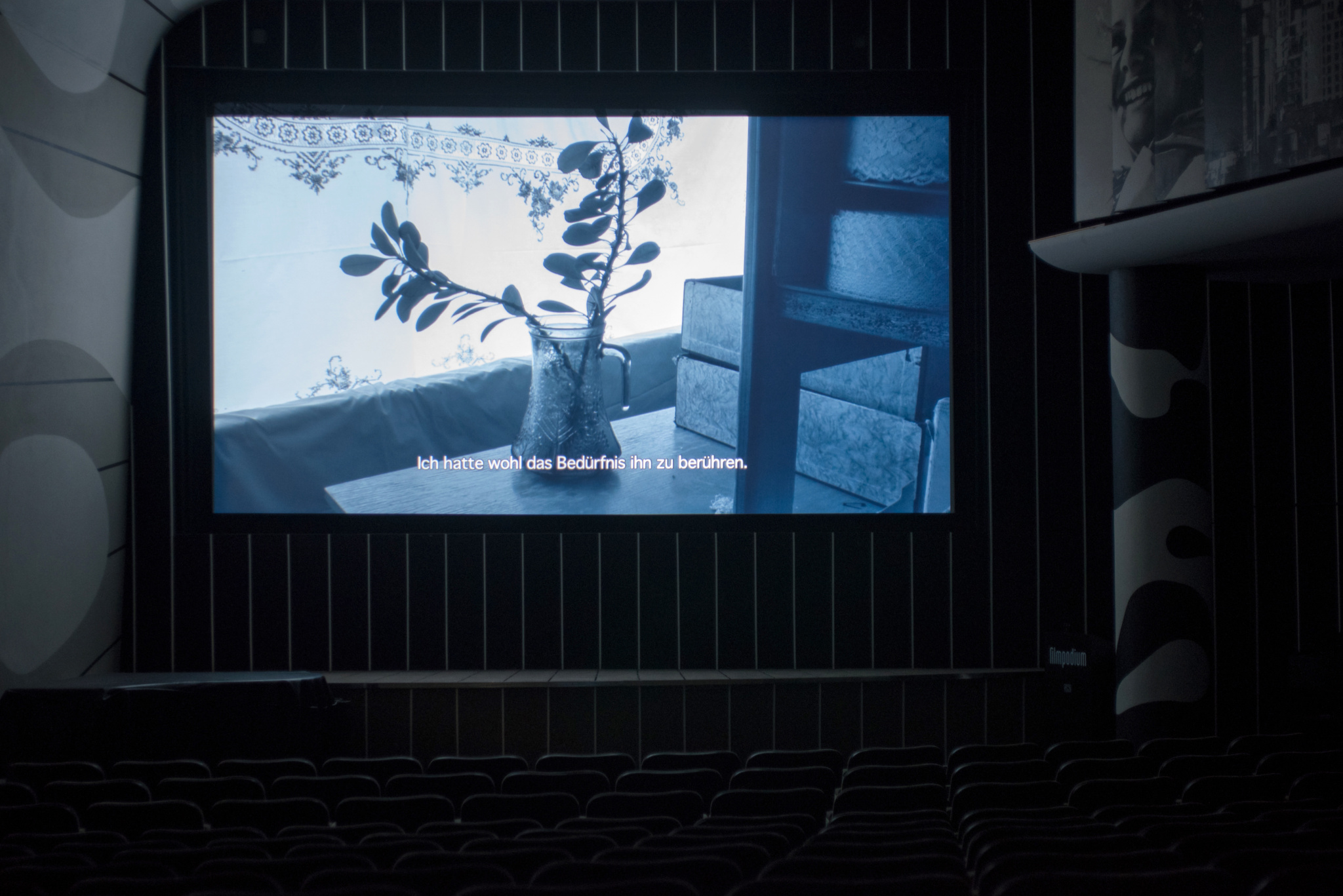
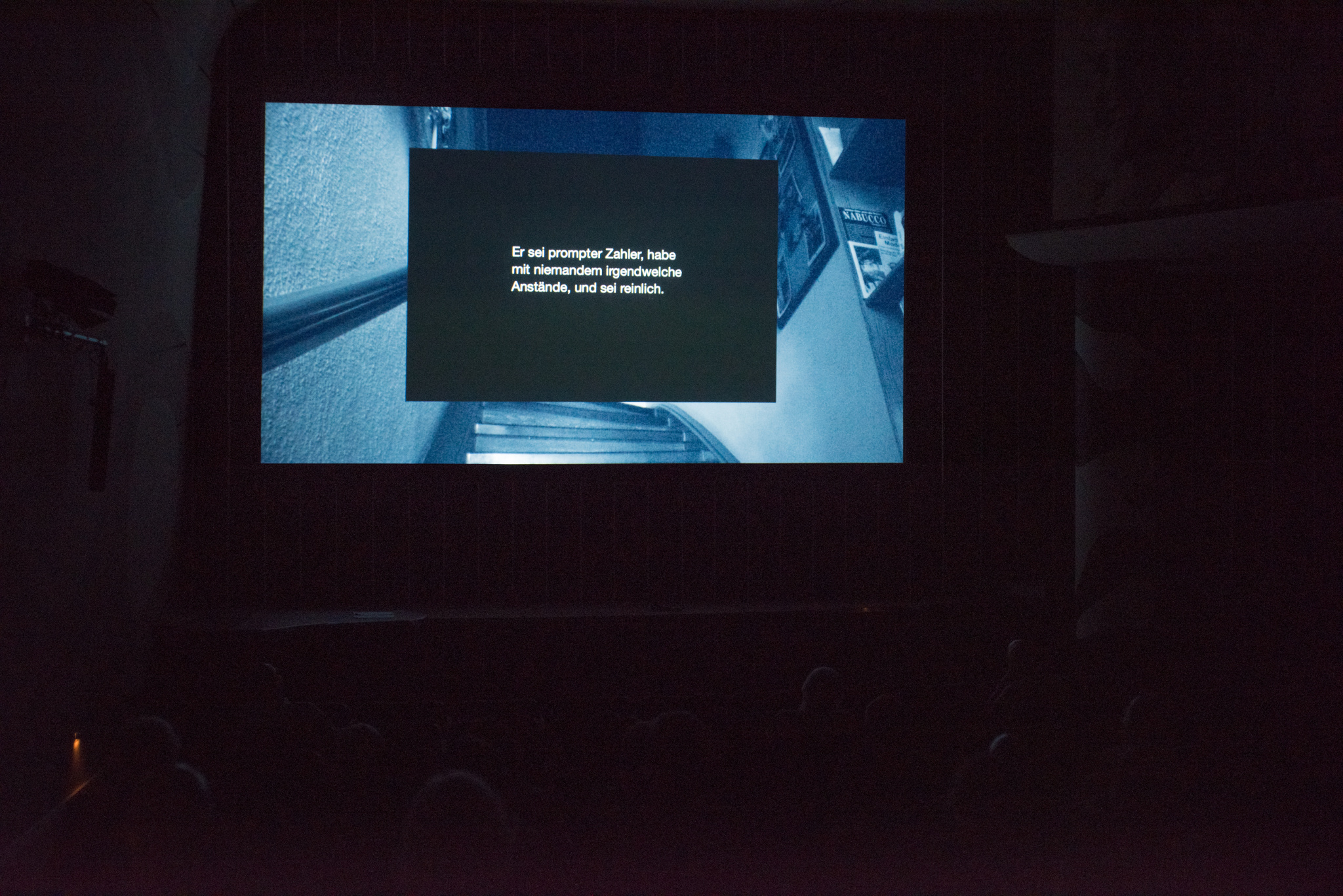
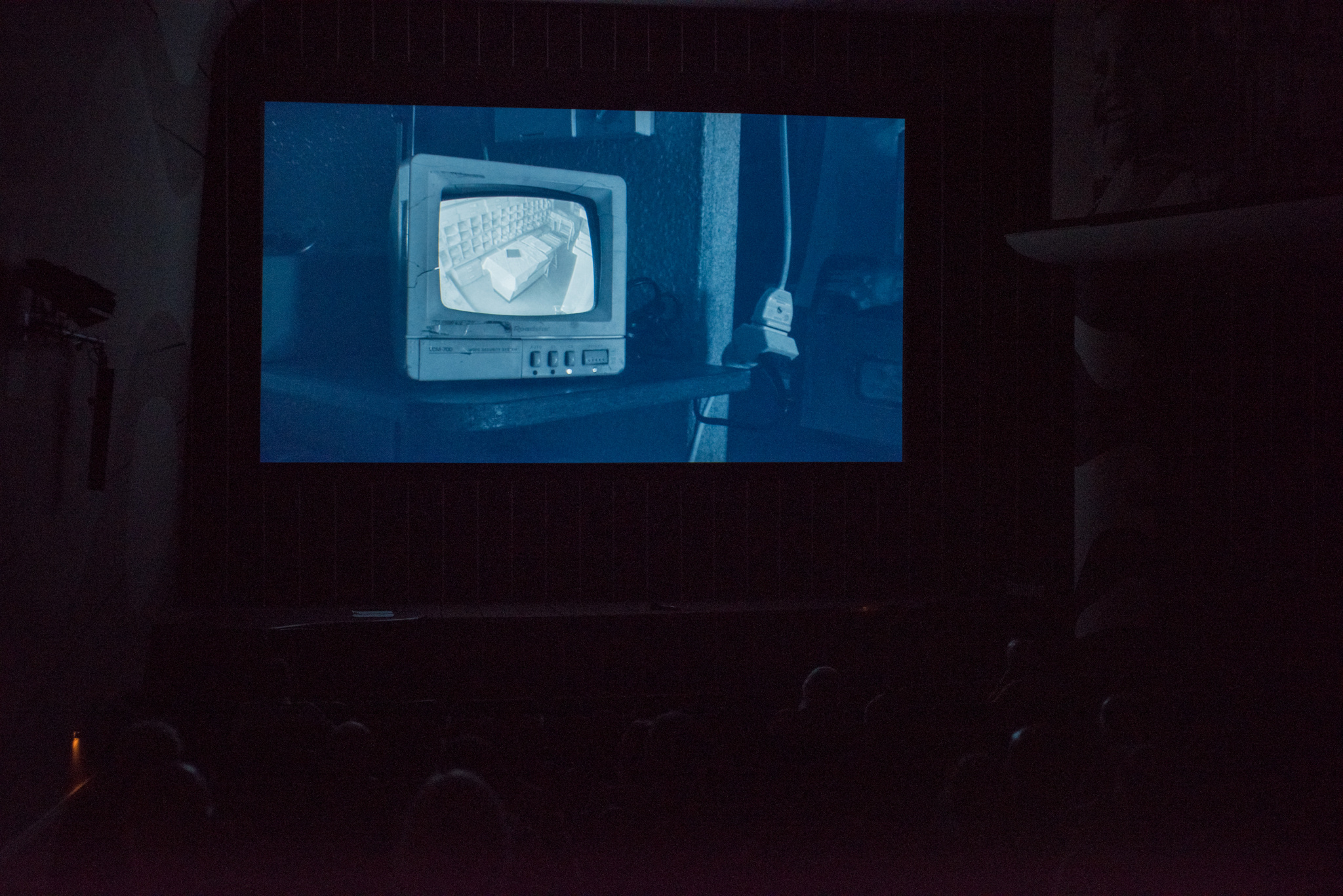
Der Kaufmann Caraco, 2017, Filmpodium Zürich 2017
Der Kaufmann Caraco, 2017, Filmpodium Zürich 2017
Der Kaufmann Caraco, 2017, Filmpodium Zürich 2017
Sequence video, Der Kaufmann Caraco, 2017
Der Kaufmann Caraco (2017)
Video projection, HD 16:9, time 10‘ 48“, loop, colour, b/w, sound
Der Kaufmann Caraco is a brief cinematic approach by the artist Françoise Caraco to the almost forgotten top dealer Abraham Caraco on Rennweg in Zurich. The existence of the man who was her great-grandson is schematically traced in the video, with the voice of the secondary character of the same name in Kurt Frühs film Hinter den sieben Gleisen, in an interview with an employee of the top dealer who has since died, with the wording of Abraham Caraco‘s Zurich naturalization file.
 September 2015
September 2015Drancy, mémoires à vif // Drancy, Memories of Lives


Exhibitionview, Drancy, mémoires à vif in the group show Werkschau 2015, Fachstelle Kultur Kanton Zürich, Museum Haus Konstruktiv, Foto: Conradin Frei, Zürich
Exhibitionview, Drancy, mémoires à vif in the group show Werkschau 2015, Fachstelle Kultur Kanton Zürich, Museum Haus Konstruktiv, Foto: Conradin Frei, Zürich
Ausschnitt Video, Drancy, mémoires, à vif
Drancy, mémoires à vif // Drancy, Memories of Lives (2015)
Video, HD 16:9, time 13' 44'', colour, audio
For a number of years Françoise Caraco has occupied herself with her family history in her work. As a descendant of an immigrant Jewish family to Basel at the beginning of the nineteen-hundreds, like many others her history has been marked by the Holocaust that cost a number of her relatives their lives. As an artist, Françoise is interested in the entanglement of personal stories, imaginary tales and collective historical awareness. In her current work, like many other descendents of Jewish families, she traces the imprints of her origins. Letters, photographs, stories and documents lead her to the Drancy internment camp outside Paris, which nearly all French Jews passed through prior to their deportation.
The unique systematization of the genocide – the inescapable net of the bureaucratic rationale of the persecution of the Jews – is crudely mirrored in the rational modernism of the housing project (Cité de la Muette), which even prior to the defeat of France had been converted into a prison. Used as an internment campy by the Vichy government, the complex not only has an architecture-historical importance but houses residents again and is presently undergoing rebuilding to return it to its original function as social housing. Over the course of decades various memorials have been installed in front of the courtyard of the U-shaped building complex, the last being a deportation railway freight carriage donated by the French railway company.
As recently as 2012 François Hollande officiated at the inauguration of a lavishly laid-out Shoah Memorial Centre opposite the site. The new building for the project was financed with monies from the unclaimed assets of Holocaust victims.
Walking around the courtyard behind the deportation carriage, now echoing with everyday life, it requires a considerable leap of imagination to be able to picture the scenes that once took place here. Realities, times clash. The residential building complex is not accessible. In Françoise Caraco’s eyes it is the run-down park at the end of the courtyard where the mood of the place is best captured. The stretch of green is barely used, looks untended, as if pervaded by a strange sense of bodily trepidation, shame. Even in the moment of one’s own physical presence there, the experience is dominated by the templates of received narratives, or equally the pre-configured perceptions formed by historical photos that permanently transmit themselves, filtered through vague insights into the history of one’s own predecessors and the notions derived from them. As the video work shows, this mediation results in still and personal reflection coupled with a gazing around the scene. An ‘active commemoration’ that distils one of the effects of the Holocaust for the descendents: a paranoid whispering – an everywhere out there whispering – soliloquy; a glance answered by the world with forbidding; a cultural unease. With her work Françoise the artist finds a stable form for this snare-like shadow on reality. She spent a year, together with her family, researching the project in Paris, where under the Nuremberg Laws she would likewise have been persecuted and deported.
Text: Oliver Caraco
 February 2015
February 2015Grandfathers Documents
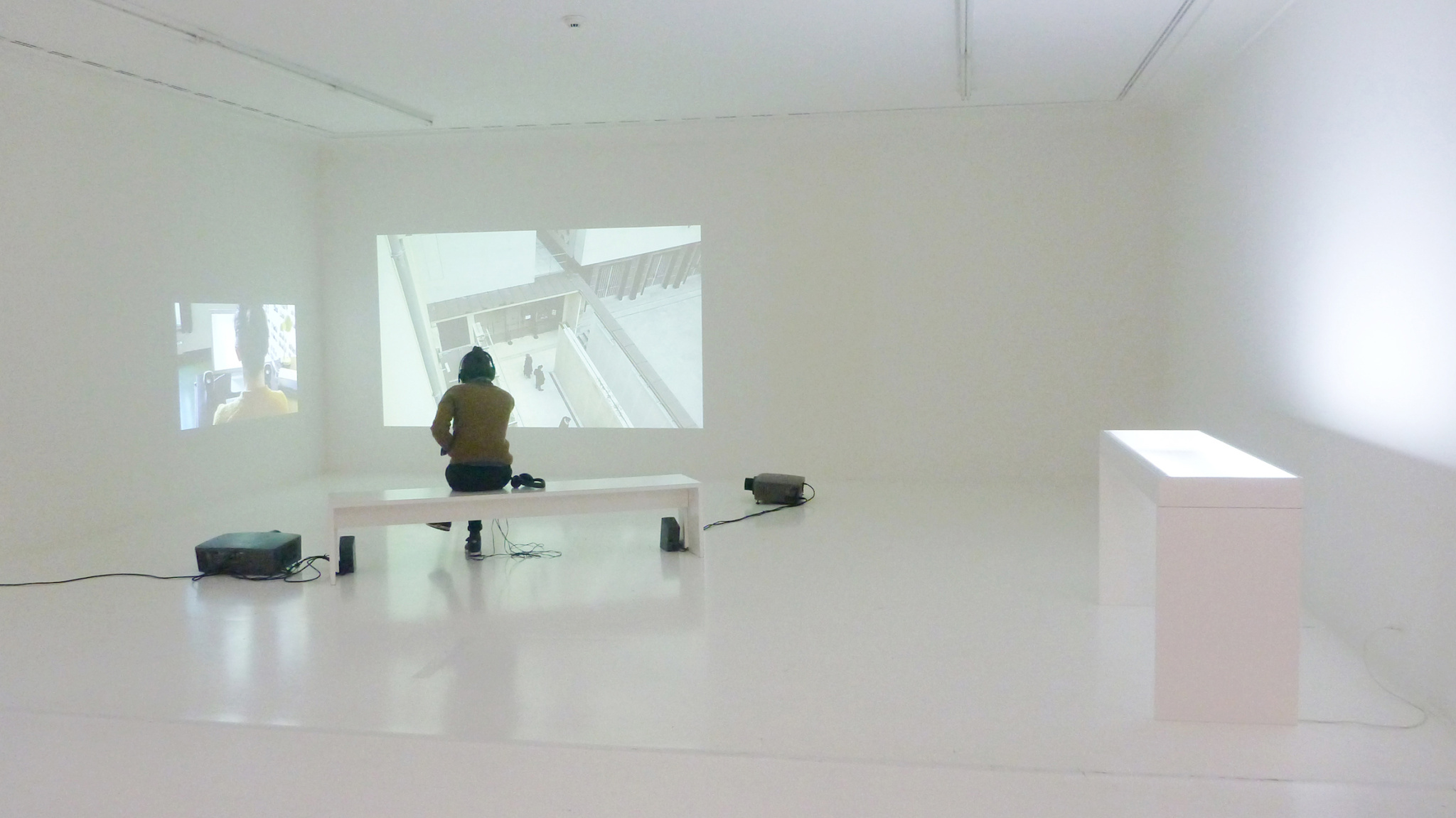
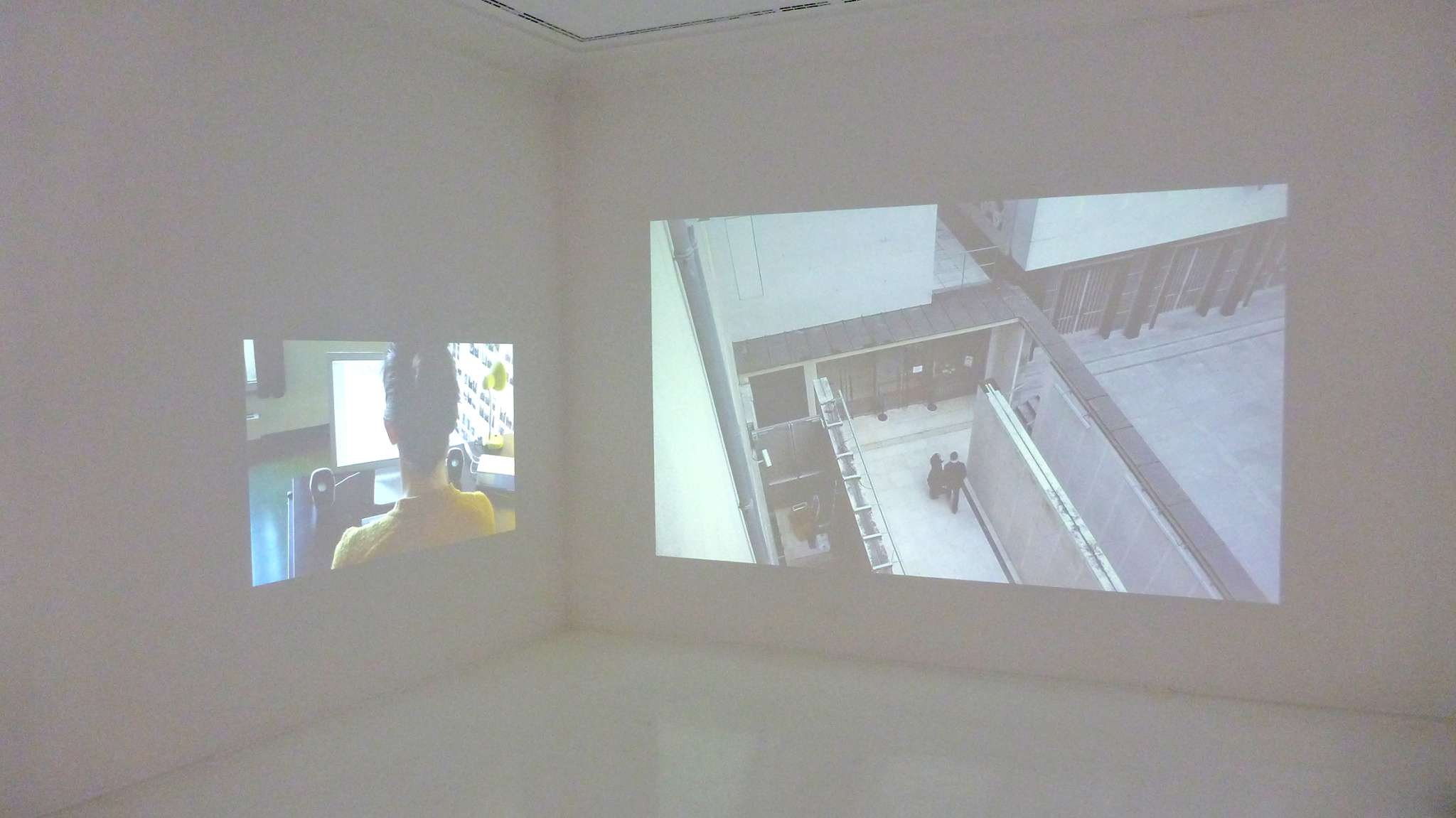
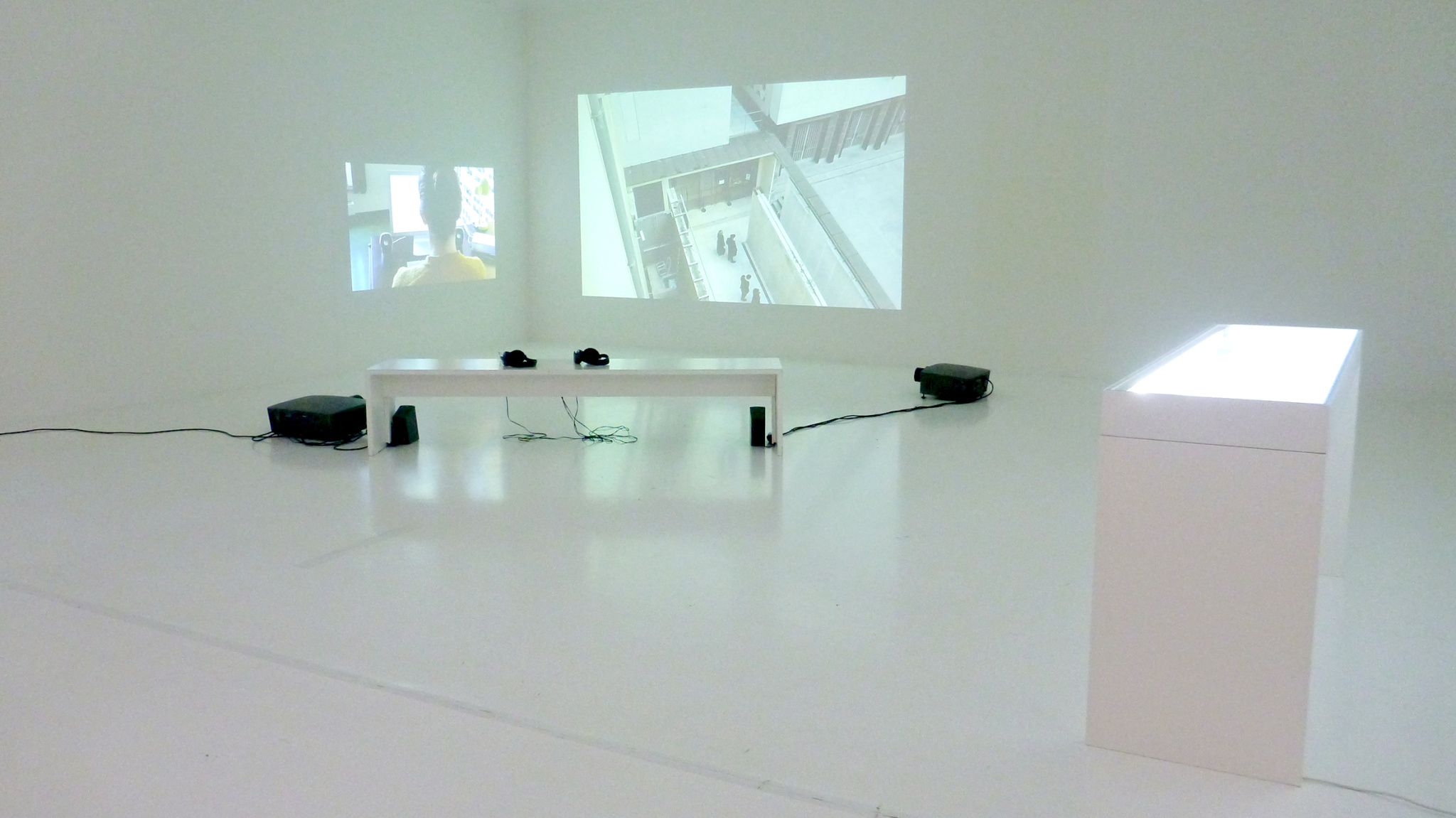
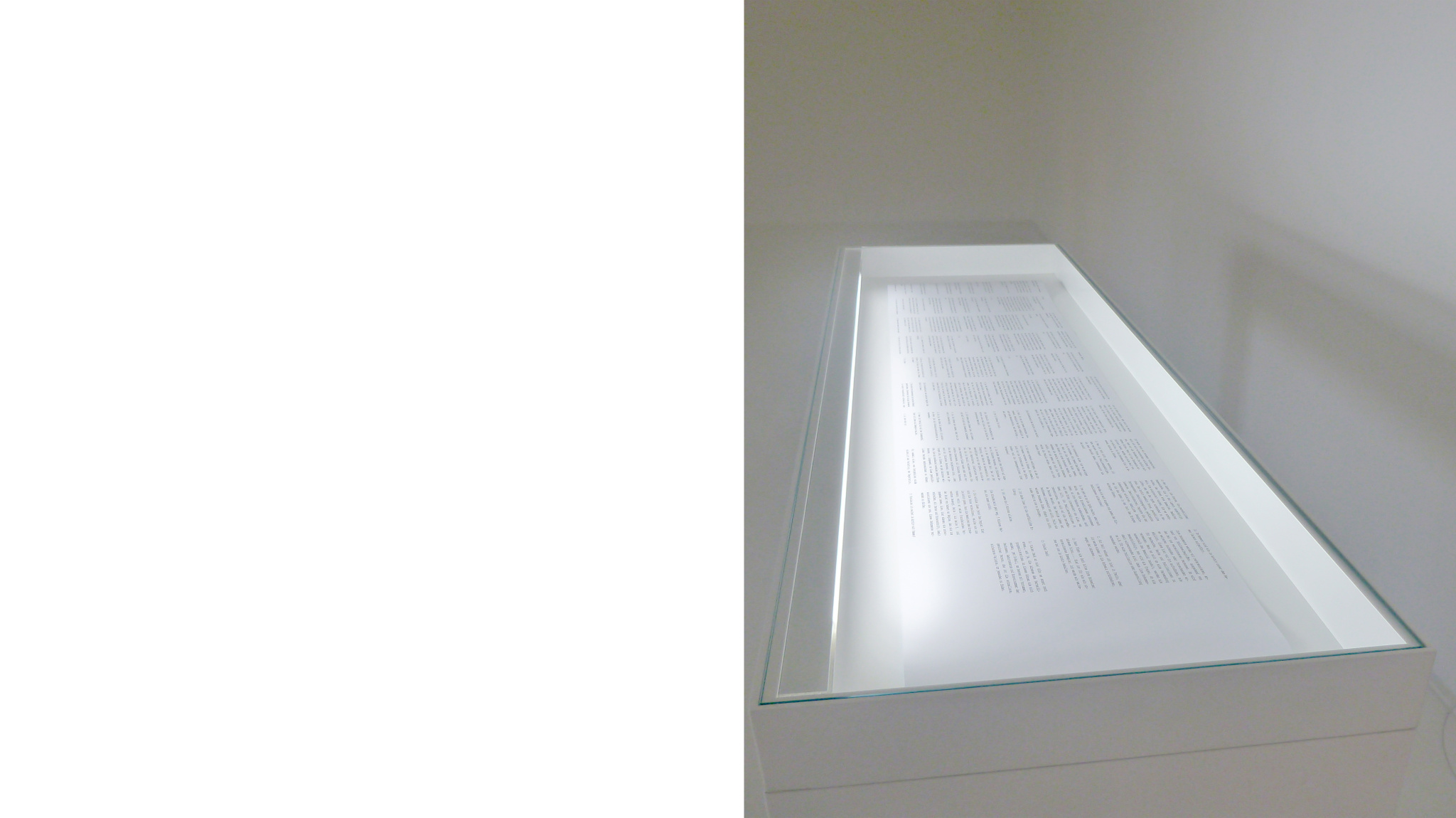
Exhibition view Grossvaters Dokumente, in der Gruppenausstellung Geschichte in Geschichten, Helmhaus Zürich 2015
Detail, Doppelprojektion Grossvaters Dokumente, in der Gruppenausstellung Geschichte in Geschichten, Helmhaus Zürich 2015
Exhibition view Grossvaters Dokumente, in der Gruppenausstellung Geschichte in Geschichten, Helmhaus Zürich 2015
Detailansicht, Transkript, Grossvaters Dokumente, in der Gruppenausstellung Geschichte in Geschichten, Helmhaus Zürich 2015
Audio work: Grossvaters Dokumente, 2015
Grossvaters Dokumente // Grandfathers Documents (2015)
Space installation, 2 Videoprojektionen, audiowork and transcript
Video, HD 16:9, 16'29''/ 20'23'', Audio work, 9'54'' spoken by Esther Becker
The ‘I’ in History.
The image would be the same. Were a historian to be filmed at work from behind it would probably look similar to the dual-channel video installation by Françoise Caraco: researching in front of the computer for sources, information, references that are then assembled to form a historical narrative. What, therefore, distinguishes an artist like Françoise Caraco from a historian? Precisely the fact that she films herself working, while a historian leaves the story he or she tells to speak for itself, or perhaps even allows themselves to become invisible behind it. Perhaps nowadays it is obvious that not only stories get authored, but that history itself does too – by ostensibly all-knowing narrators, from a specific perspective, with very definite interests. It comes as no surprise that history as a discipline is sometimes still taught as if its texts were engraved in stone, prescribed from a higher authority.
Françoise Caraco is on a par, if not better than a historian. A transcript of her encounter with a member of staff from a Paris archive dedicated to collecting source material on missing Jewish persons makes it apparent just how scrupulously Caraco undertook her search for her grandfather’s French relatives during her stay in France. The photographs and documents left by her grandfather have now become a part of the archive. Nevertheless, Caraco is not a historian. She recounts stories in the first person – in a text transmitted via headphones. In this narrative she herself passes the ‘mur des noms’ of the Mémorial de la Shoah – located directly opposite her temporary Paris studio, and which she likewise shows in her film footage – and reads the engraved names of the disappeared. And, importantly, she shows herself at work. The ‘I’ in Caraco’s form of history is written large.
Artists have learnt a lot from historians. But what can historians learn from artists? One example is that video – a predominant medium in this exhibition – can also serve to recount history. And that one can hide oneself behind a camera as easily as one can hide oneself behind an authoritarian authorship that excludes the first person. But there is nothing inevitable about this, as Françoise Caraco demonstrates in text and film.
Text: Daniel Morgenthaler for the exhibition Geschichten in Geschichte (Histories in History), curated by Daniel Morgenthaler, Helmhaus Zurich, 2015
 November 2013
November 2013Deposits
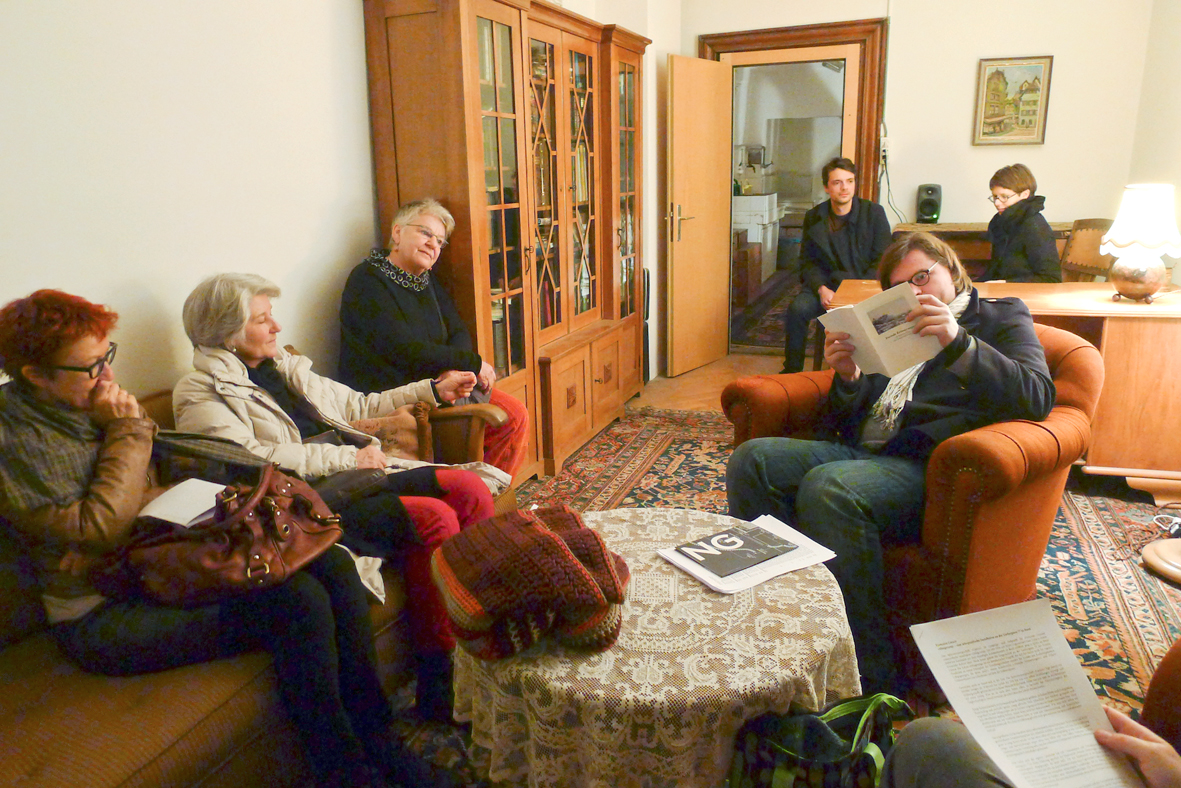
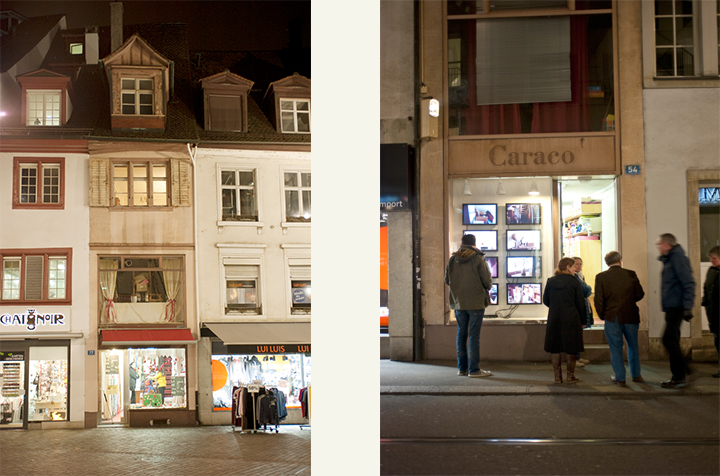
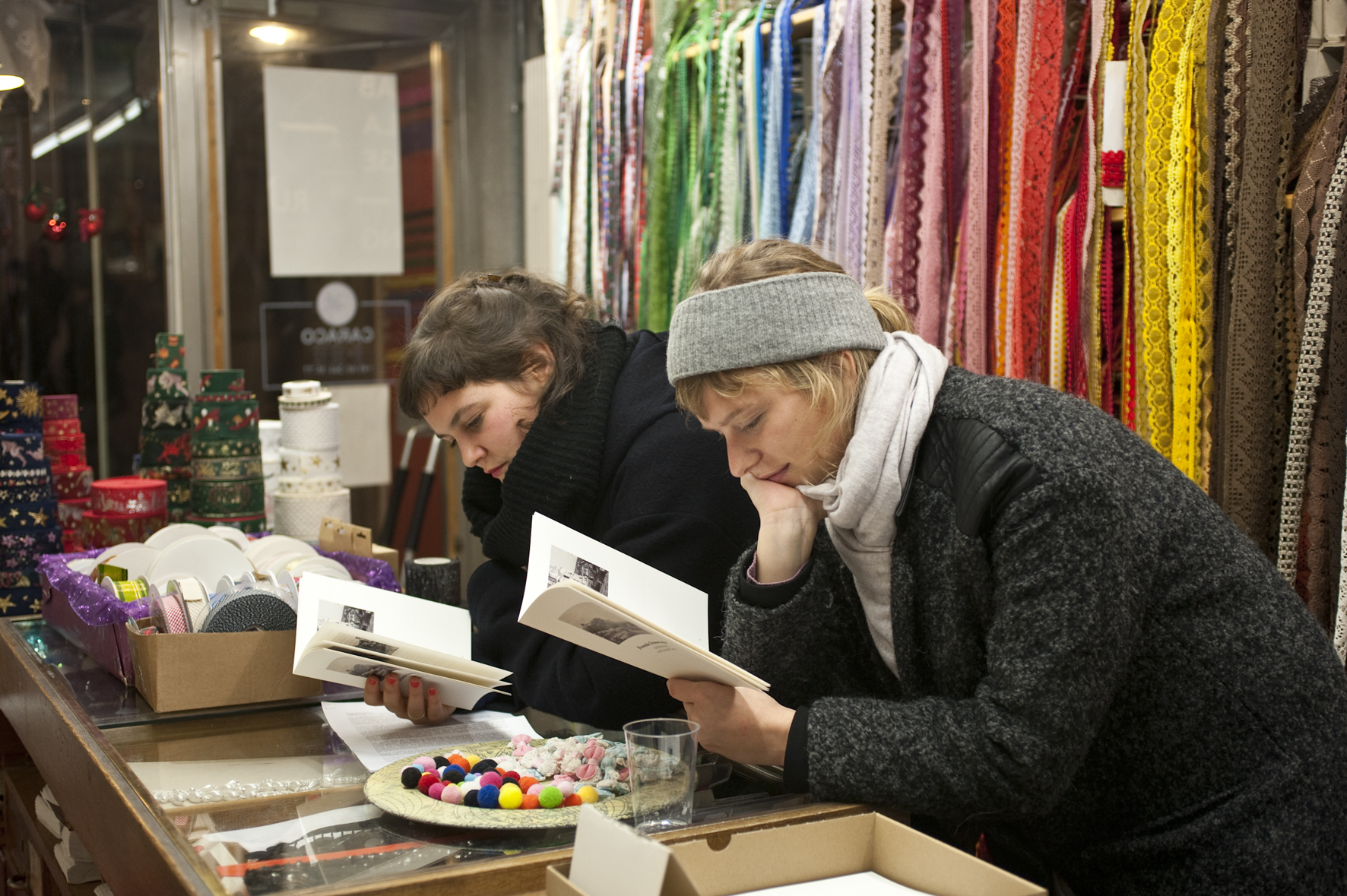

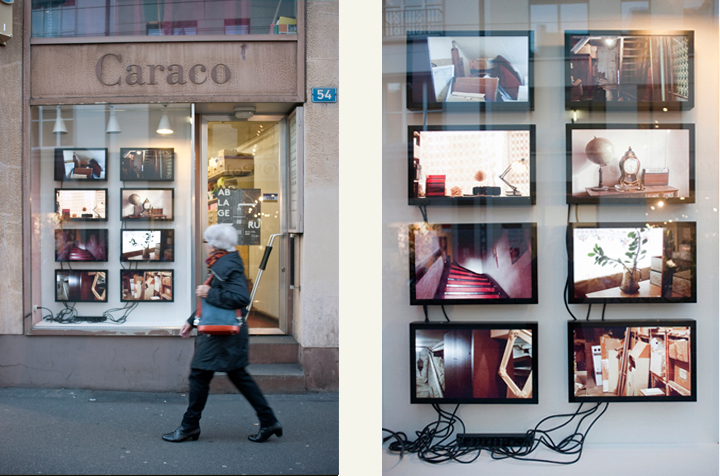
Site specific installation, audio work; Begegnungen, die keine sind, in the lace shop Caraco Basel, 2013
The lace shop Caraco Basel, 2013
Site specific installation, Reisebericht: Fremde Erinnerungen, in the lace shop Caraco Basel, 2013
Site specific installation, Ablagerung, in the lace shop Caraco Basel, 2013
Site specific installation, Hinterräume, 8 Videos in the exhibition, Ablagerung, in the lace shop Caraco Basel, 2013
Audio work; Begegnungen, die keine sind, 2013
Ablagerung // Deposits (2013)
Site-specific installation in the ‘Caraco’ lace shop.
Audio work: Begegnungen, die keine sind , 3' 12" in loop, 2013
Travel journal: Fremde Erinnerungen (Borrowed Memories), laser-print, 2013
Videos displayed on eight monitors, Hinterräume (Backrooms), HD 16:9, varying playback lengths in loop, 2013
The lace shop ‘Caraco’ is the point of departure and the endpoint for Françoise Caraco’s site-specific installation Ablagerung. Opened in 1914 in Basle by the artist’s great-grandfather Isaac Caraco, a Jewish merchant from what was then Constantinople, the business was later taken over by her grandfather Robert. Today the property at Gerbergasse 77 still belongs to the Caraco family. The work Ablagerung is an artistic intervention involving a search by Françoise Caraco for her own history, beginning at a site in her family tree. The work consists of audio fragments (Begegnungen, die keine sind), a travel journal (Fremde Erinnerungen) and videos (Hinterräume) in the display windows on the Falknerstrasse side of the building.
History plays itself out in space and in time. The ‘Caraco’ lace shop is eloquent testimony to this fact. Whilst the scaffold of time creates stories as if almost by itself, and establishes an order, in the same breath it commands defiance. Everything that was and is appears here in one fell swoop. That which is, is open on all sides; the synchronicity of non-synchronicity prevails – a condition referred to in the eight videos of the work Hinterräume.
The artist has opened a number of cardboard boxes containing archive material, revealing letters and photographs, sales slips and valuable laces. Many of the other boxes, however, remain stacked an unopened. They are deposits[i2] , reaching out to today as signs of times gone by. The fact that their surfaces are dusty does nothing to detract from their meaningfulness. Just as one can never entirely gauge oneself, and then only by recounting, so all genealogical research and history writing includes gaps. Each time something is found out, somewhere else a new and unknown domain appears.
The unopened archive boxes serve as proxies for this unknowingness. Lives and historical correlations can not be told mimetically – if merely because it would entail any recital lasting as long as the life itself or the sequence of events per se. It is only the omissions and the emphasises that show something about one’s self, or of former times. The immediate connotation of Françoise Caraco’s installation is that in this context the narrative configuration is a possible given prerequisite for verisimilitude.
Each search for a personal history must face failings and the unuttered. These experiences find expression in the travel journal Fremde Erinnerungen and the audio fragment Begegnungen, die keine sind. For the story of her journey the artist travelled to Turkey with a collection of family photos from 1935 taken in her great-grandfather’s birthplace Ortaköy. The seemingly self-evident nature of the plan to match the notions evoked by the photos with the experiences of visiting the place where they originated from dissolves in Ortaköy. The confrontation turns the seeker into a visitor, obliged to recognise that there are alien aspects to her story that will remain precisely so: alien.
A similar force becomes apparent in the attempt to converse with her relations. In Begegnungen, die keine sind scraps of correspondence left behind by her great-grandfather and her grandfather are interwoven with the hesitant exchanges between living family members.
The fragmentary character of the audio recordings is a reference to the lacunae without which a story cannot function. Nevertheless, Françoise Caraco’s installation abstains from utilizing the true force of story telling, namely to resolve disparities in experiences and to make junctures and misunderstandings seem more explicable. By this means the search for her own story also stands for the general inability that codetermines every glance backwards, and at one’s self.
It is not a coherent narrative that sustains the correlations in Françoise Caracos work Ablagerung, intrinsically rather the rooms of the ‘Caraco’ lace shop – as a junction in history.
Text: Alain Gloor
 November 2013
November 2013Reisebericht, Fremde Erinnerungen, 2013
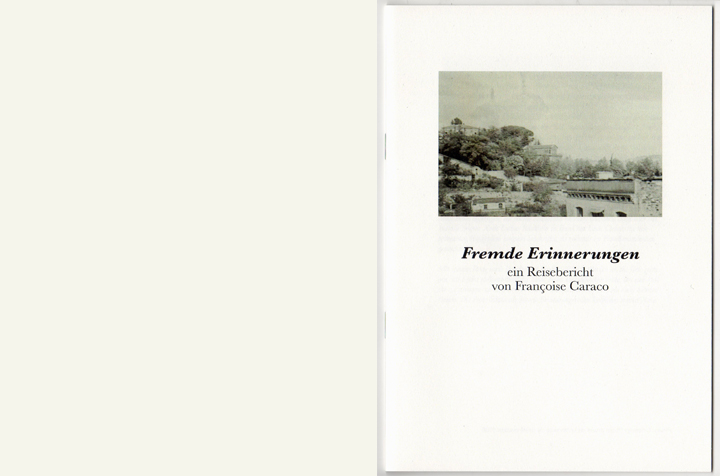

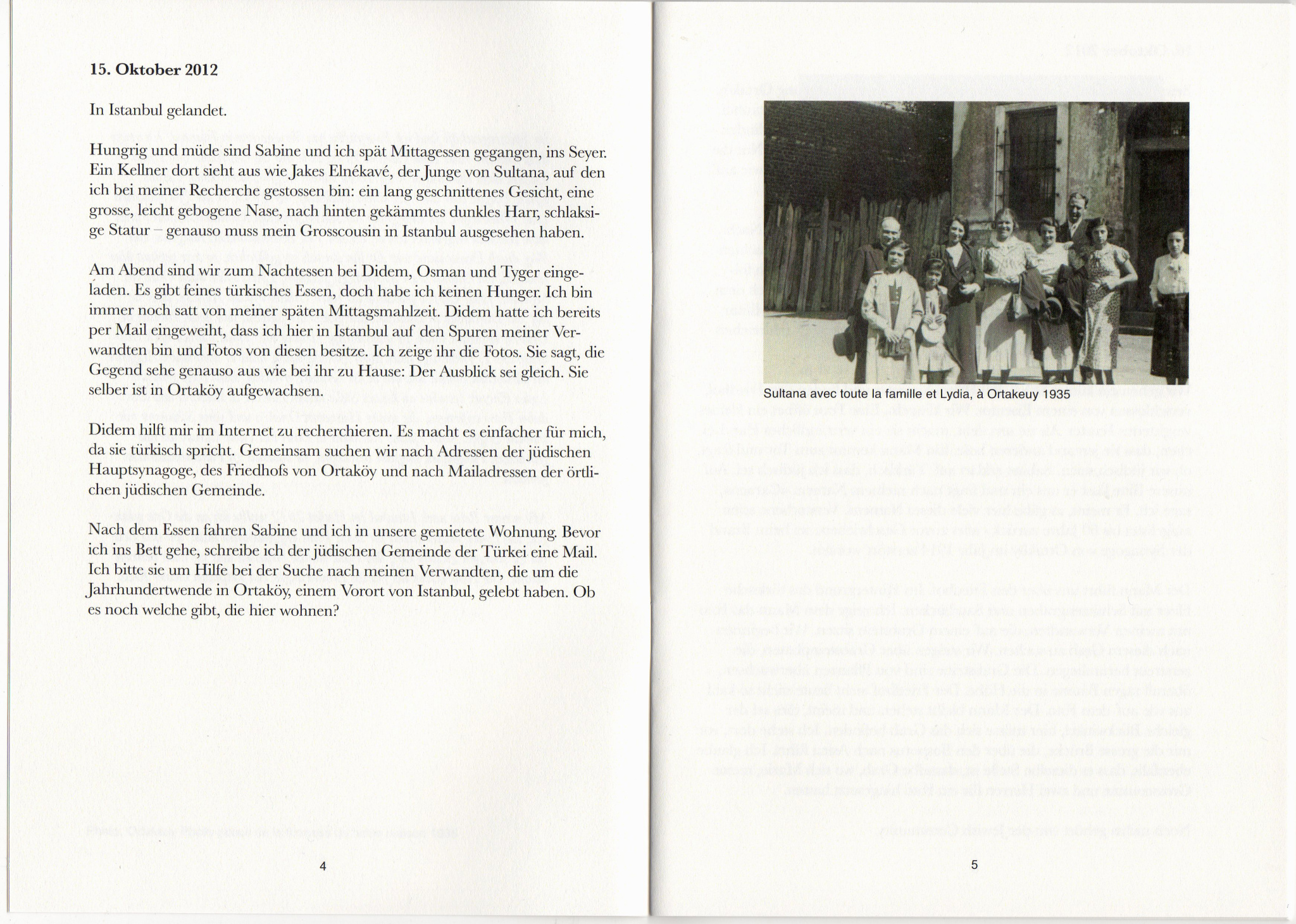
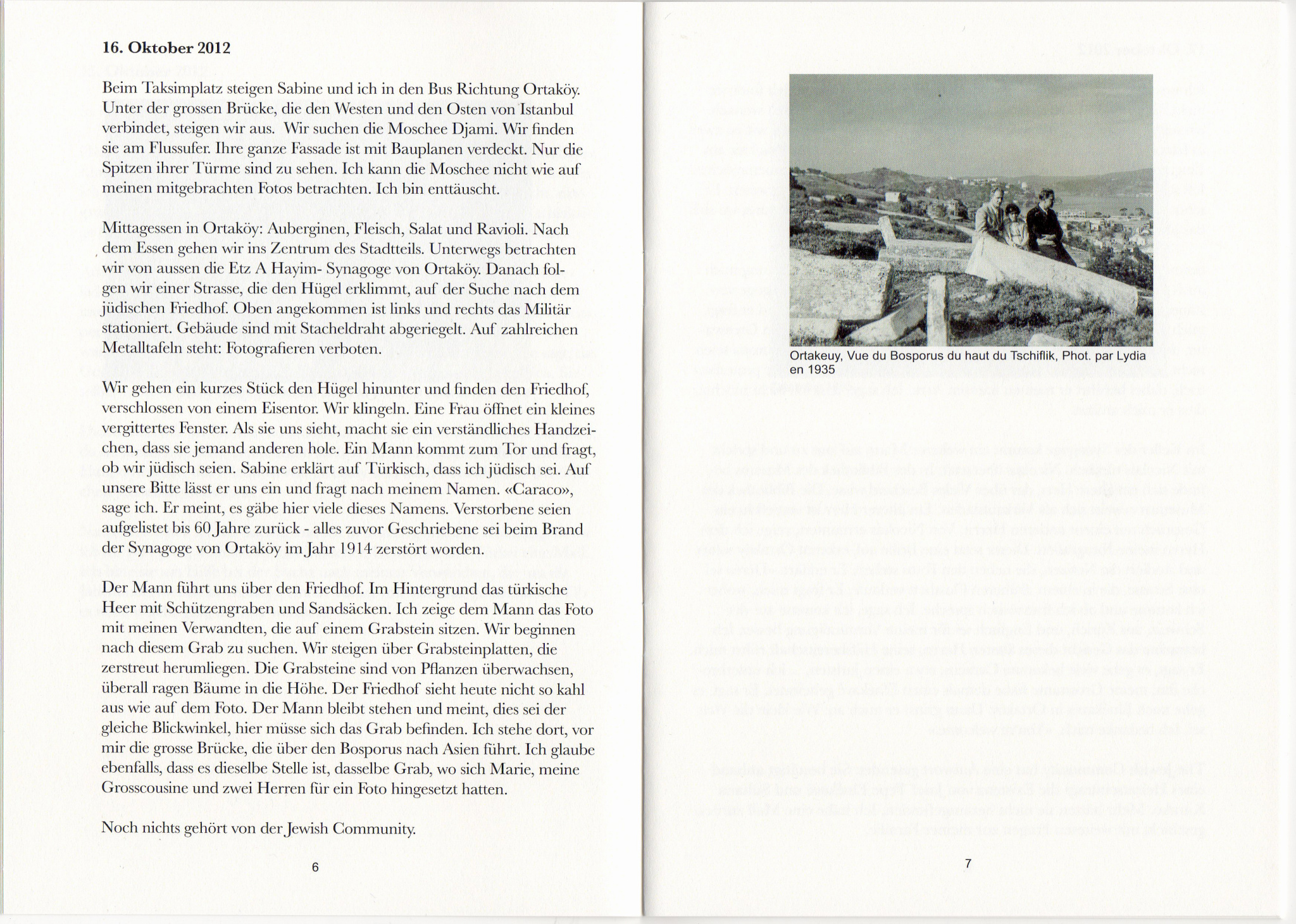
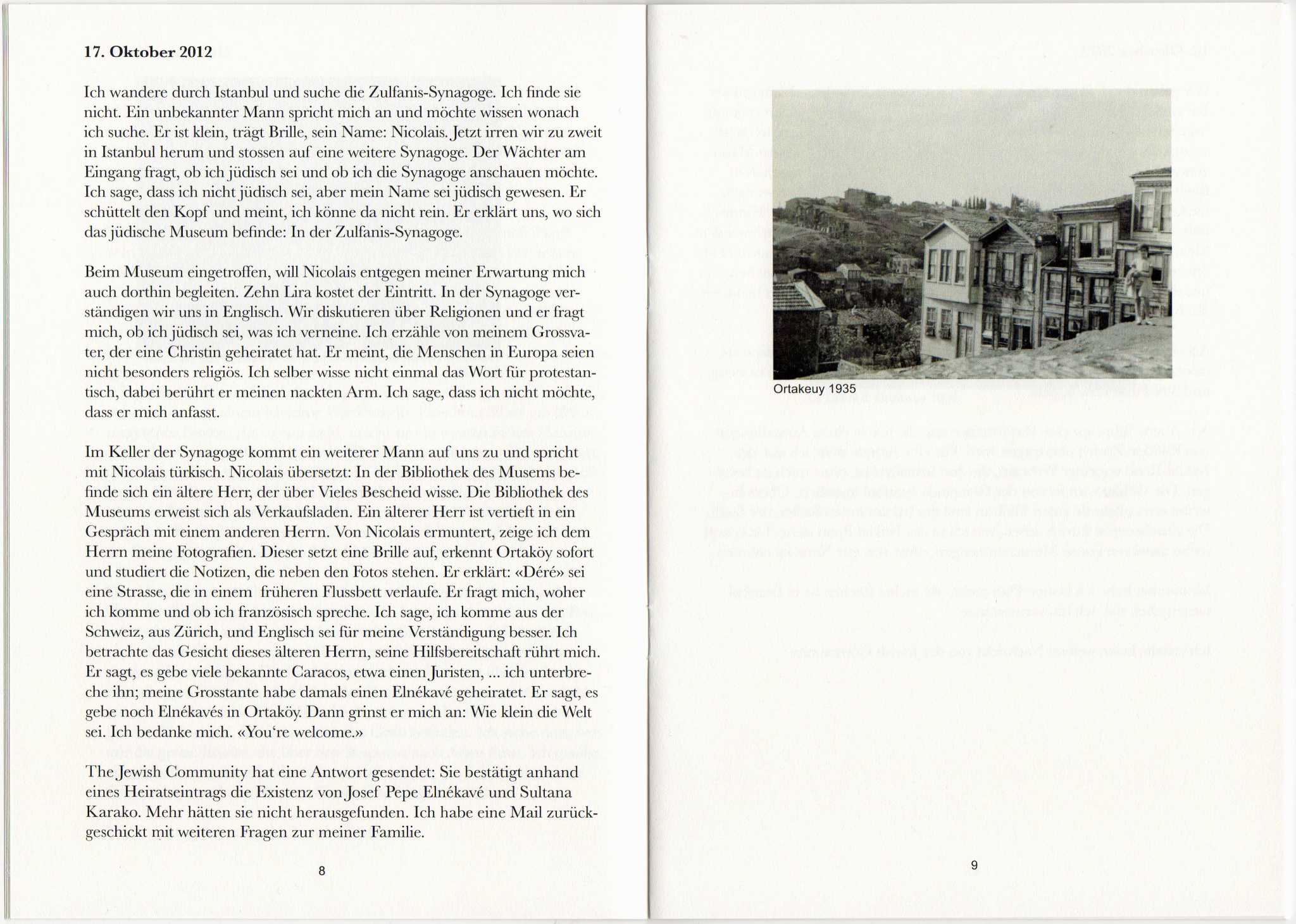
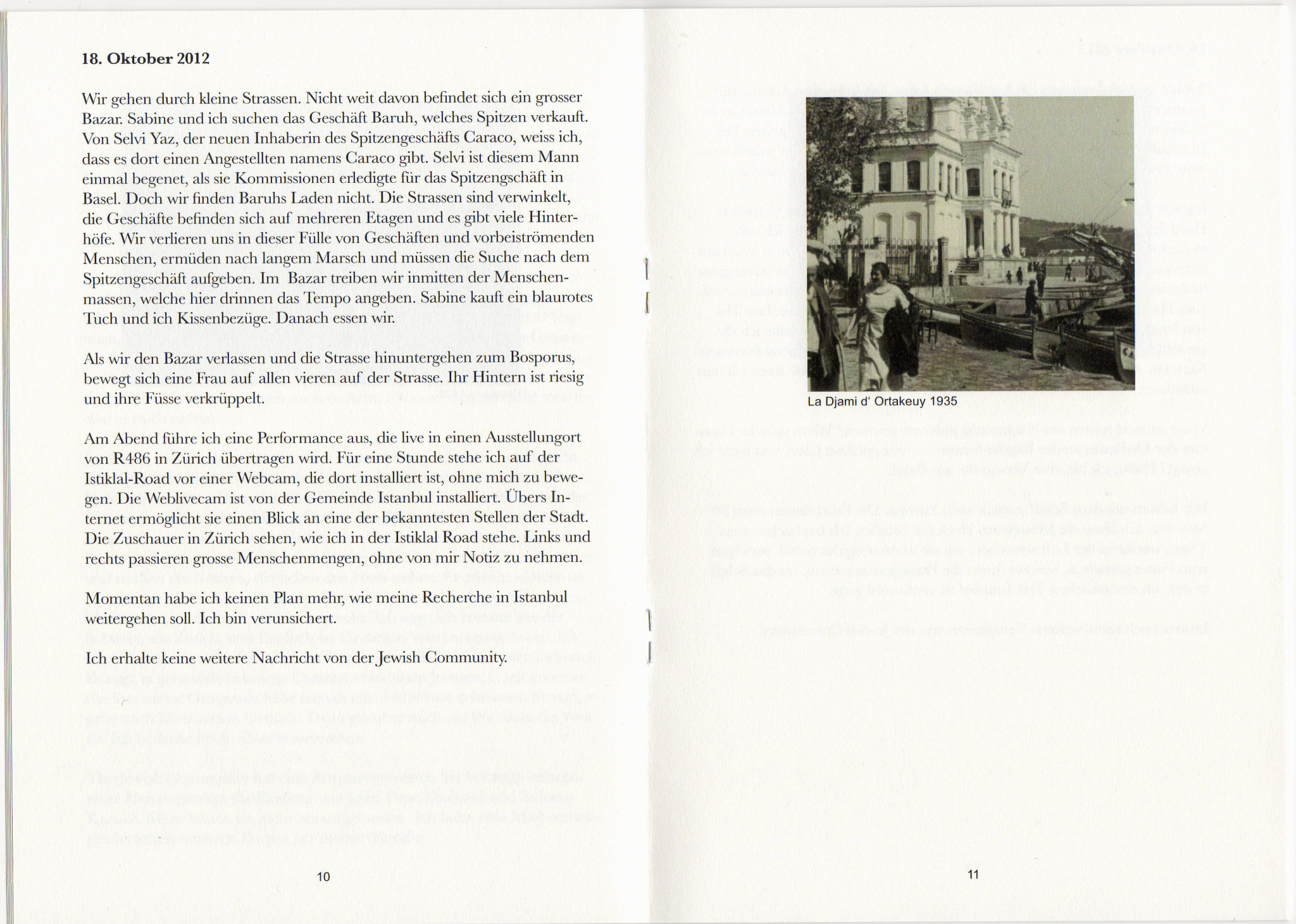
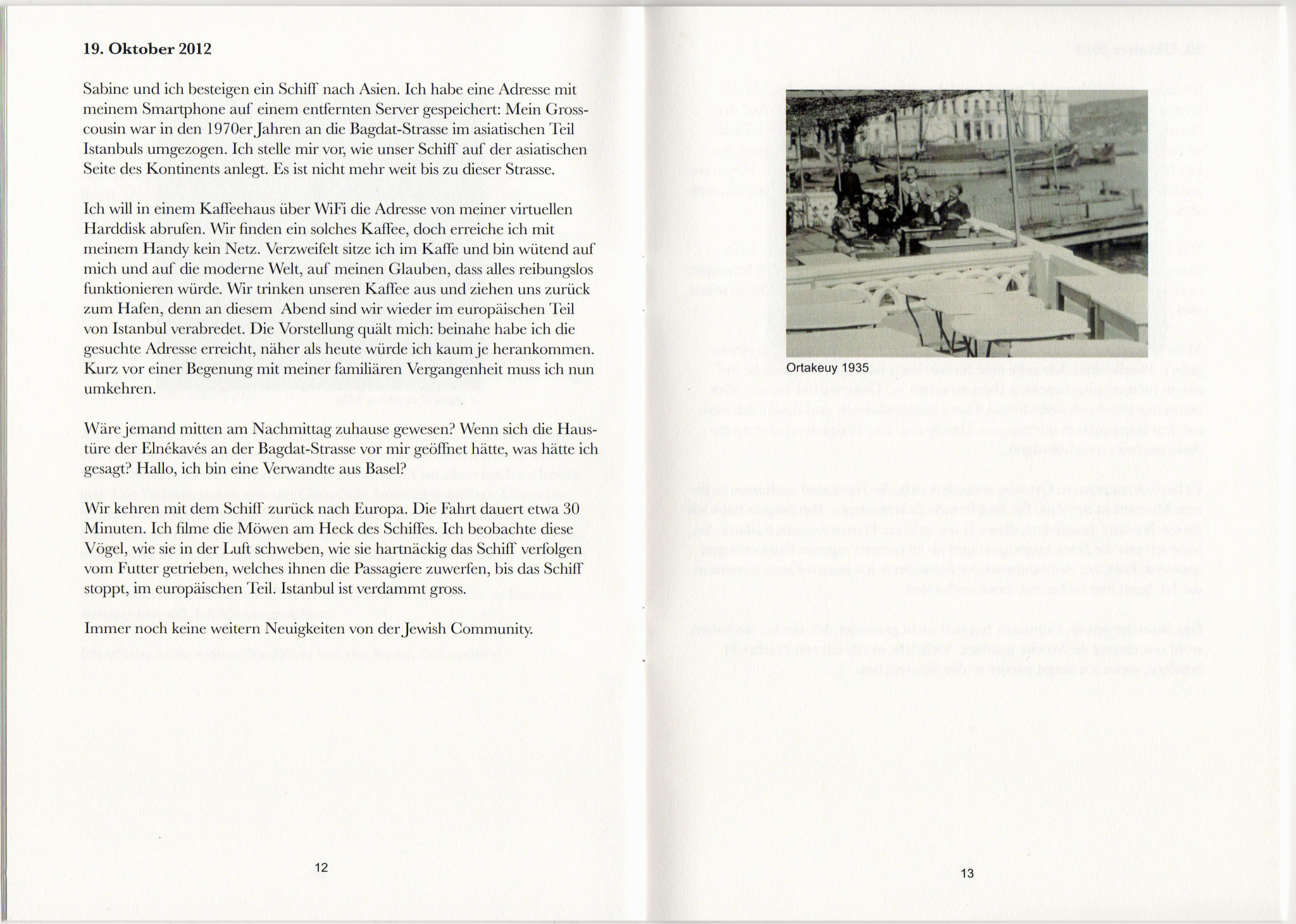
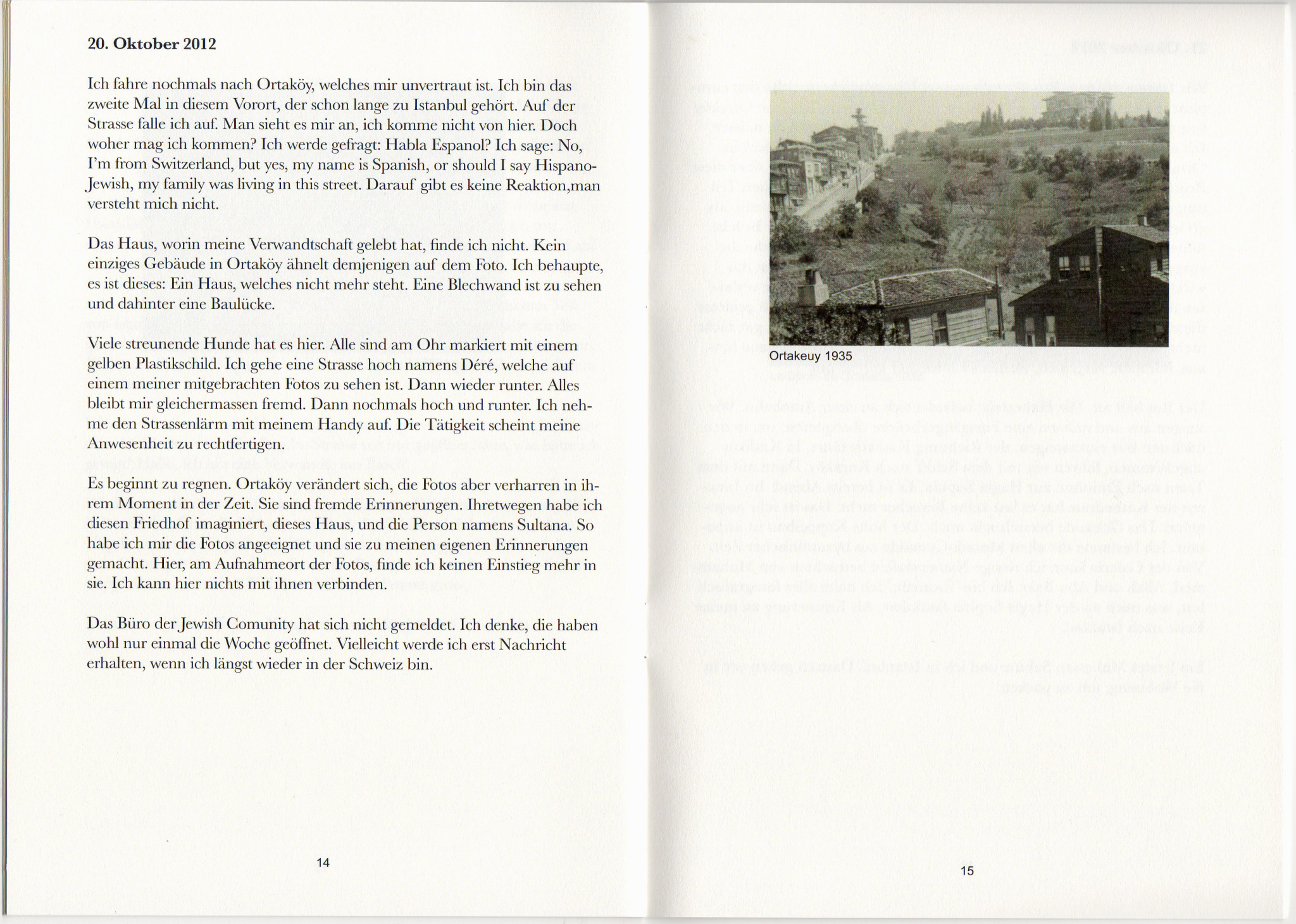

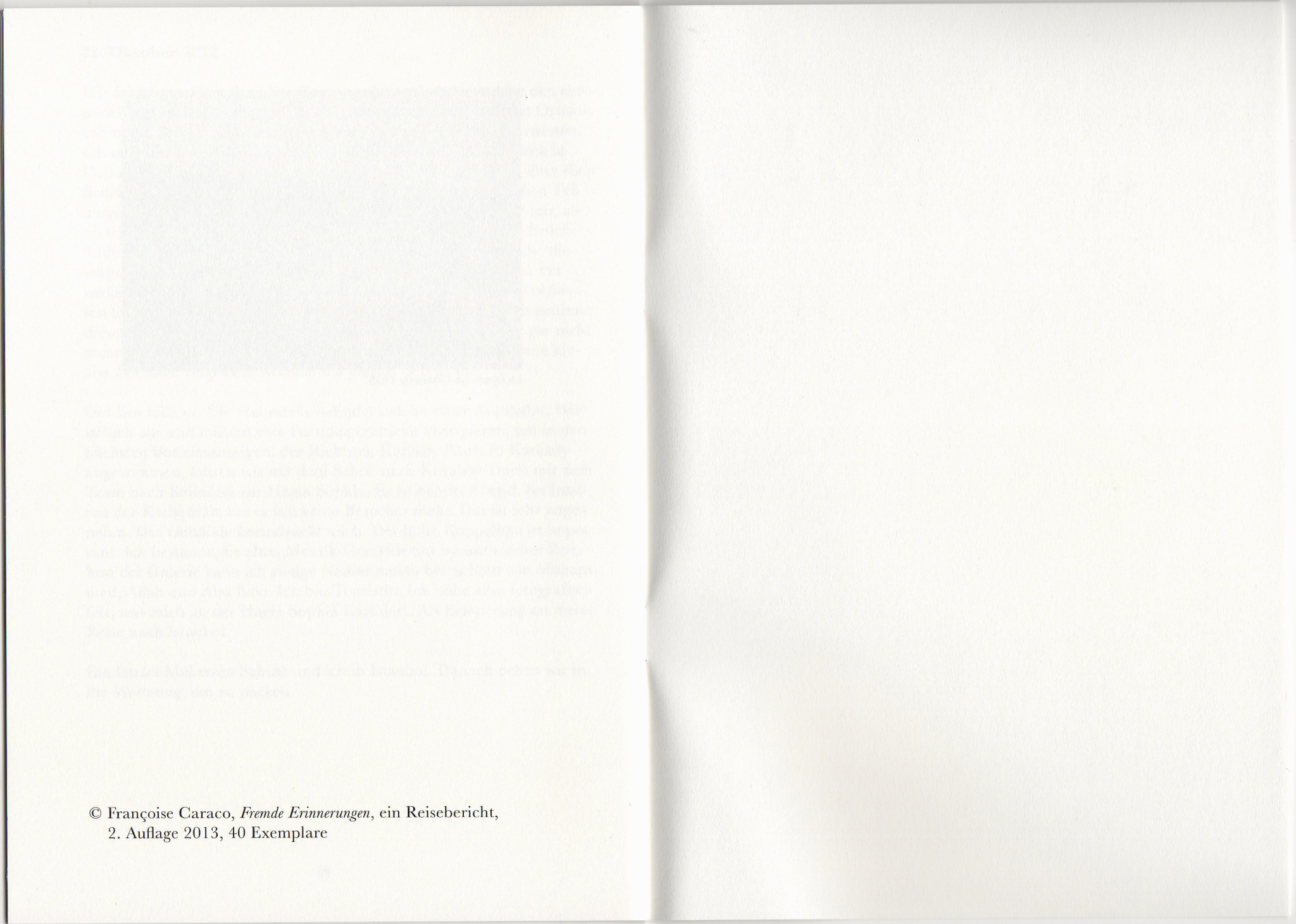
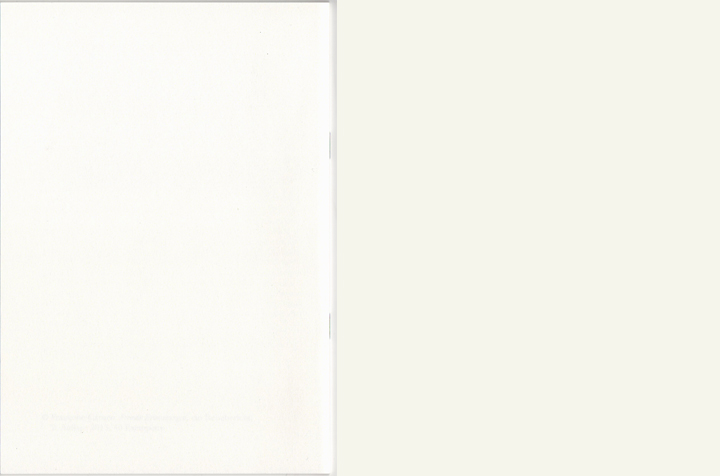
Travelogue A5: Fremde Erinnerungen, Laserprint, 2013
Travelogue A5: Fremde Erinnerungen, Laserprint, 2013
Travelogue A5: Fremde Erinnerungen, Laserprint, 2013
Travelogue A5: Fremde Erinnerungen, Laserprint, 2013
Travelogue A5: Fremde Erinnerungen, Laserprint, 2013
Travelogue A5: Fremde Erinnerungen, Laserprint, 2013
Travelogue A5: Fremde Erinnerungen, Laserprint, 2013
Travelogue A5: Fremde Erinnerungen, Laserprint, 2013
Travelogue A5: Fremde Erinnerungen, Laserprint, 2013
Travelogue A5: Fremde Erinnerungen, Laserprint, 2013
 July 2013
July 2013Family Photos I, II, III


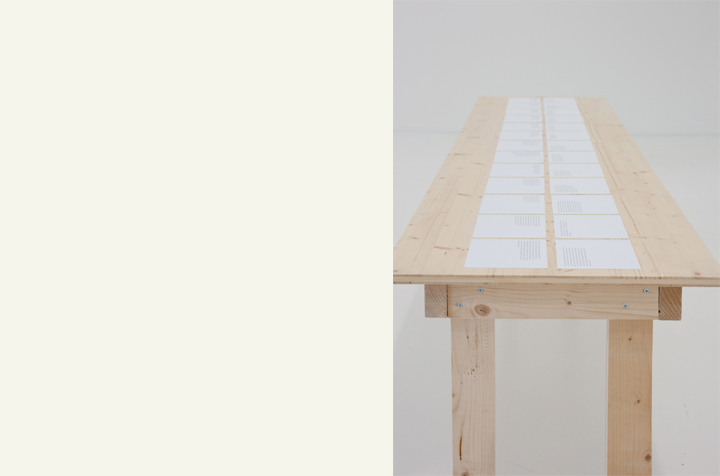


Exhibition view Familienfotos I,II, III, in the group show Stipendien- und Atelierwettbewerb, Helmhaus Zürich 2013
Detail view: Familienfotos I,II, III, Helmhaus Zürich 2013
Detail view: Familienfotos I,II, III, Helmhaus Zürich 2013
Detail view: Familienfotos I,II, III, Helmhaus Zürich 2013
Detail view: Familienfotos I,II, III, Helmhaus Zürich 2013
Audio work: Familienfotos III, 5' 32'' , by loop
Ausschnitt Video: Familienfotos I, HD 16:9, 2:33 min
Familienfotos I, II, III – Family Photos I, II, III (2013)
I: Video projection, HD 16:9, time 2' 33", in loop
II: 26, A5 filing cards, laser-print on paper
III: Audio work, time 5' 30", loop, speaker Esther Becker
Françoise Caraco tackles the story of her grandfather’s life. In the process, the absorbing of her own personal family history represents a gesture of connection: it serves her as an opportunity to reconstruct and reflect on the public and political circumstances of a bygone era. In the work Familenfotos, Françoise Caraco constructs an experimental layout of familial and social belonging and broaches the subject of the demarcations involved. To do so she uses portrait pictures and fragments of information from letters from 1904 to 1942 kept by her grandfather, the son of a Sephardic-Jewish immigrant from Istanbul.
Family Photos is a spatial installation in which Françoise Caraco stages a collection of photos and text fragments inherited from her grandfather. From her own contemporary perspective Caraco repeats her grandfather's attempts, based on family photos and written documents, to ascertain the presence of his relatives. The basis materials for Caraco are photographs, postcards and letters that relatives sent from their respective new ‘home countries’. In Caraco’s presentation these items become historic documents, revealing less about the concrete life situations of the family and instead posing more questions about public states-of-mind as seen from an intimate perspective.
The artist has taken the available and patchy archive material from the early twentieth century, carefully reviewed it, interpreted the content and formally transformed it. The customary black-and-white family portraits from the epoch have been translated into short texts in which she tries to descriptively reconstruct the interrelations between the depicted people themselves and with the simultaneously transported contexts. Caraco deploys an actress to read aloud the written details of the dates and locations derived from the respective pictures in the form of a mundane list. The empty reverse sides of the photos on which family members are shown are transformed by the artist into abstract pictures, projected in sequence with textual fragments from the written correspondence onto a wall. Using these three forms of translation Caraco reconstructs links and correlations that generate a new present-day image of the past. At the same time the blank reverses and the fragmented texts indicate losses and voids.
Familienfotos queries the medium of photography in the widest possible sense as a form of documentation. What can photography transport and how? What are its claims to truthfulness and its possibilities? Caraco understands a photograph as a document that is not always readily legible. As such, to begin with she found the photographs left by her grandfather indecipherable. She was unable to either recognise or sort the people depicted. Based on the identical source material, in an attempt to make it decipherable Caraco evolved three different forms of translation that endow the fleeting documents with a new coherence. Whether a private past can be reconstructed from these translations remains moot – the question being whether the product is not simply a construed reality, a fiction. It is precisely at this crux that we are re-confronted with a paradox expressed by Hito Steyerl: ‘Doubts as to their truth-value do not make documentary images weaker, rather stronger.’
Text: Irene Grillo, 2013
 February 2013
February 2013Fortuna Esther
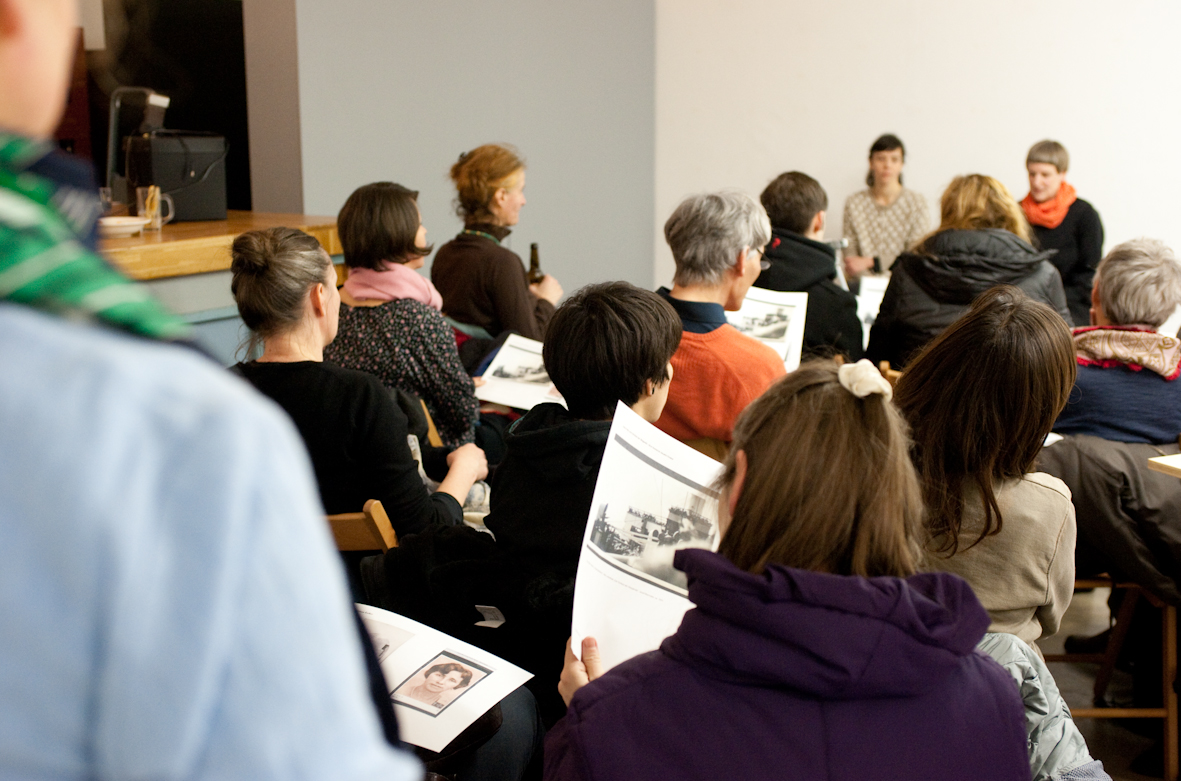
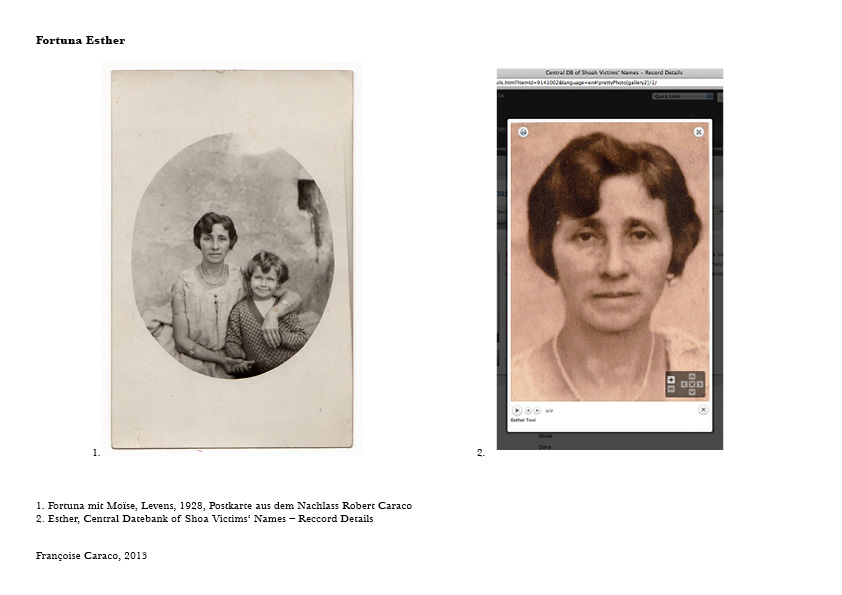
Lecture performance by Françoise Caraco for the exhibition Fergangenheit, Fake, Fiktion (Foregoing, Fake, Fiction), teamwork with Nicole Biermaier, Corner College, Zurich 2013
Beiblatt zur Lectureperformance von Françoise Caraco, Fortuna Esther,
Fortuna Esther (2013)
Lecture performance by Françoise Caraco for the exhibition Fergangenheit, Fake, Fiktion (Foregoing, Fake, Fiction), Corner College, Zurich
In my lecture performance, using the example of a private family photo I recount how problematic I found it can be to retrospectively reconstruct the existence of a deceased person when their history is fragmentary.
I discovered two photos of a women who is related to me, each of them with different identifications, on the one hand as Fortuna and on the other as Esther. It becomes doubtful whether as evidence photographs have the power to foster personal identity.
There is no doubt that both Fortuna and Esther existed: both are mentioned in my grandfather’s ancestral tree, both are likewise listed in a database of the Shoah. But which one is sitting facing me on the photo holding the young Moïse in her arms remains obscure.